Research Project on Remote Healthcare Monitoring
VerifiedAdded on 2020/05/01
|35
|9851
|37
AI Summary
Contribute Materials
Your contribution can guide someone’s learning journey. Share your
documents today.
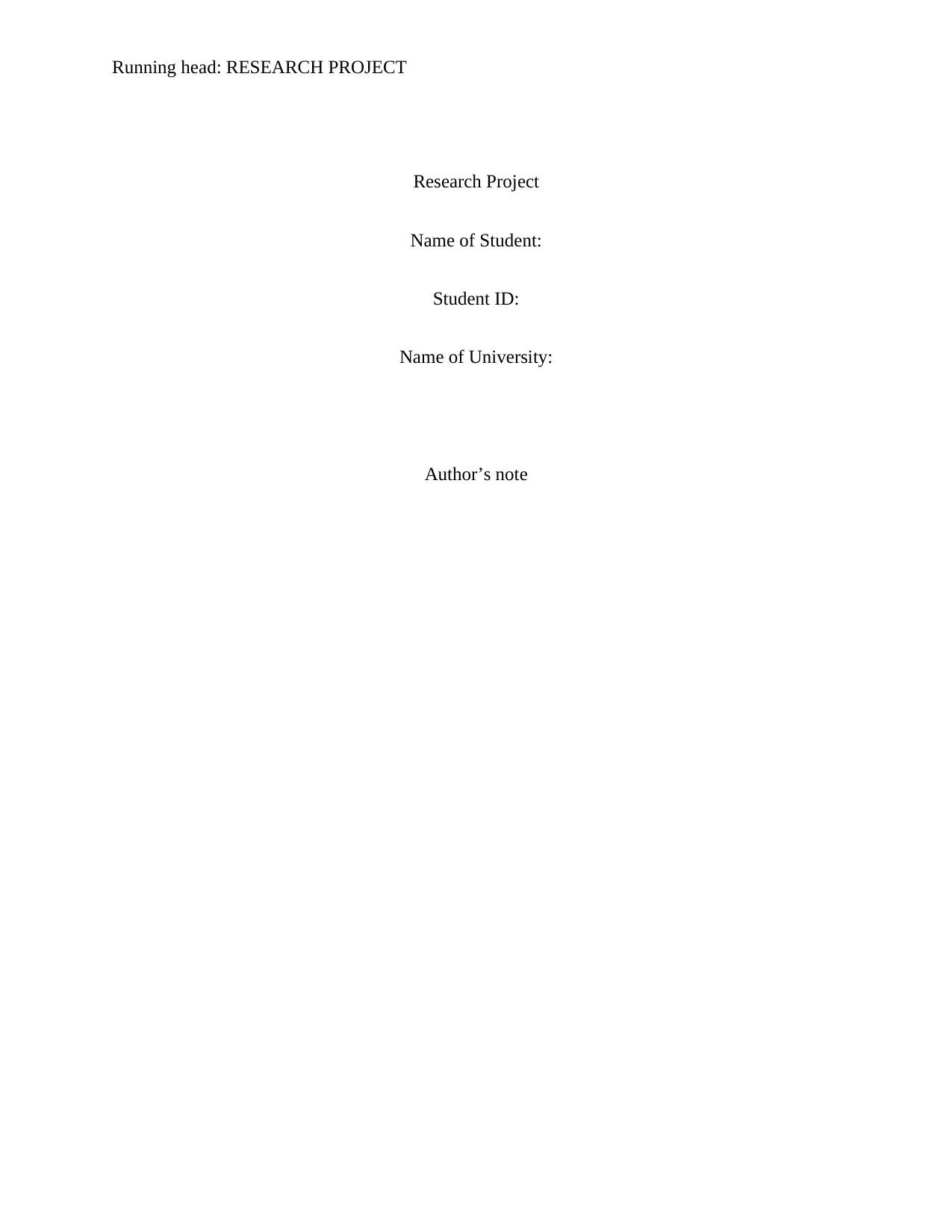
Running head: RESEARCH PROJECT
Research Project
Name of Student:
Student ID:
Name of University:
Author’s note
Research Project
Name of Student:
Student ID:
Name of University:
Author’s note
Secure Best Marks with AI Grader
Need help grading? Try our AI Grader for instant feedback on your assignments.
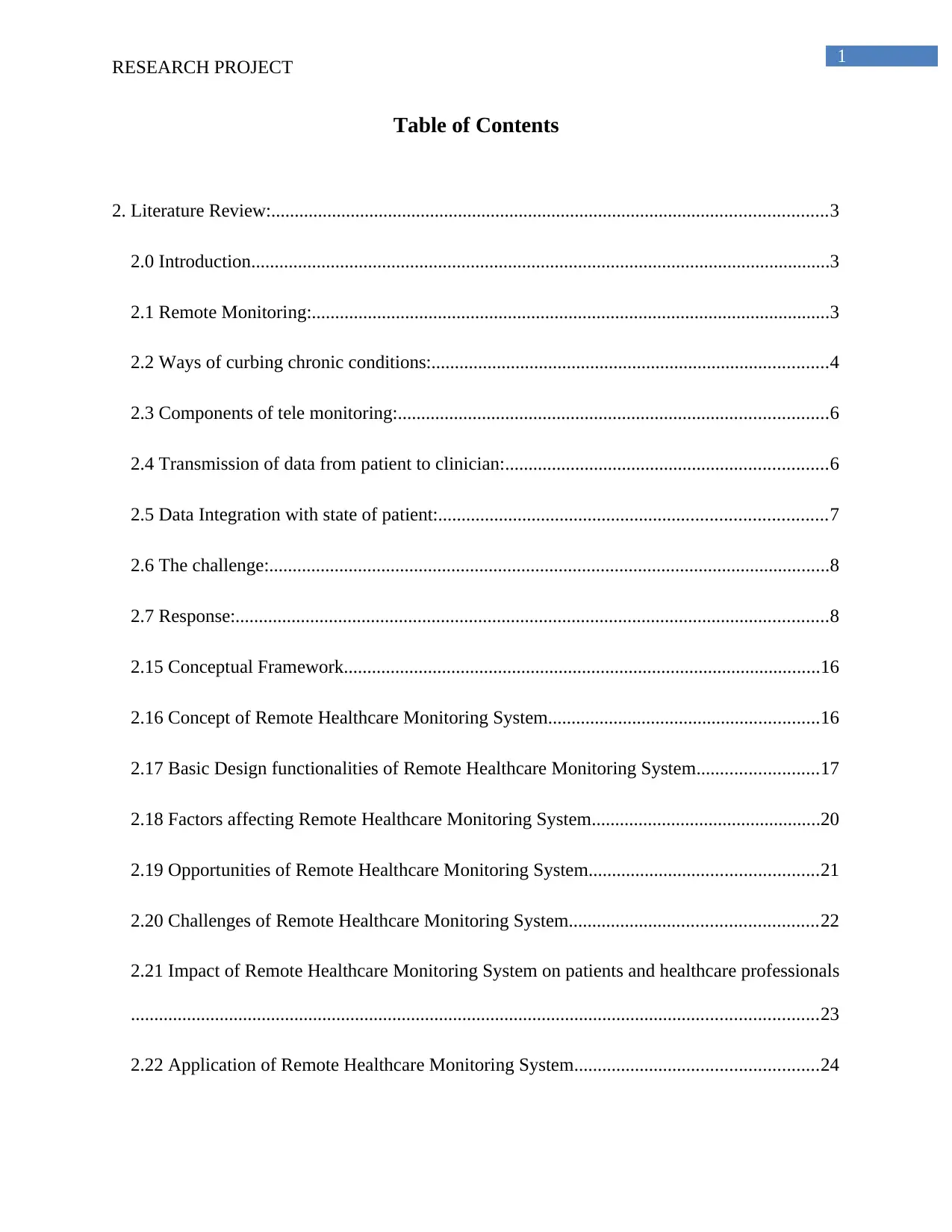
1
RESEARCH PROJECT
Table of Contents
2. Literature Review:.......................................................................................................................3
2.0 Introduction............................................................................................................................3
2.1 Remote Monitoring:...............................................................................................................3
2.2 Ways of curbing chronic conditions:.....................................................................................4
2.3 Components of tele monitoring:............................................................................................6
2.4 Transmission of data from patient to clinician:.....................................................................6
2.5 Data Integration with state of patient:...................................................................................7
2.6 The challenge:........................................................................................................................8
2.7 Response:...............................................................................................................................8
2.15 Conceptual Framework......................................................................................................16
2.16 Concept of Remote Healthcare Monitoring System..........................................................16
2.17 Basic Design functionalities of Remote Healthcare Monitoring System..........................17
2.18 Factors affecting Remote Healthcare Monitoring System.................................................20
2.19 Opportunities of Remote Healthcare Monitoring System.................................................21
2.20 Challenges of Remote Healthcare Monitoring System.....................................................22
2.21 Impact of Remote Healthcare Monitoring System on patients and healthcare professionals
...................................................................................................................................................23
2.22 Application of Remote Healthcare Monitoring System....................................................24
RESEARCH PROJECT
Table of Contents
2. Literature Review:.......................................................................................................................3
2.0 Introduction............................................................................................................................3
2.1 Remote Monitoring:...............................................................................................................3
2.2 Ways of curbing chronic conditions:.....................................................................................4
2.3 Components of tele monitoring:............................................................................................6
2.4 Transmission of data from patient to clinician:.....................................................................6
2.5 Data Integration with state of patient:...................................................................................7
2.6 The challenge:........................................................................................................................8
2.7 Response:...............................................................................................................................8
2.15 Conceptual Framework......................................................................................................16
2.16 Concept of Remote Healthcare Monitoring System..........................................................16
2.17 Basic Design functionalities of Remote Healthcare Monitoring System..........................17
2.18 Factors affecting Remote Healthcare Monitoring System.................................................20
2.19 Opportunities of Remote Healthcare Monitoring System.................................................21
2.20 Challenges of Remote Healthcare Monitoring System.....................................................22
2.21 Impact of Remote Healthcare Monitoring System on patients and healthcare professionals
...................................................................................................................................................23
2.22 Application of Remote Healthcare Monitoring System....................................................24
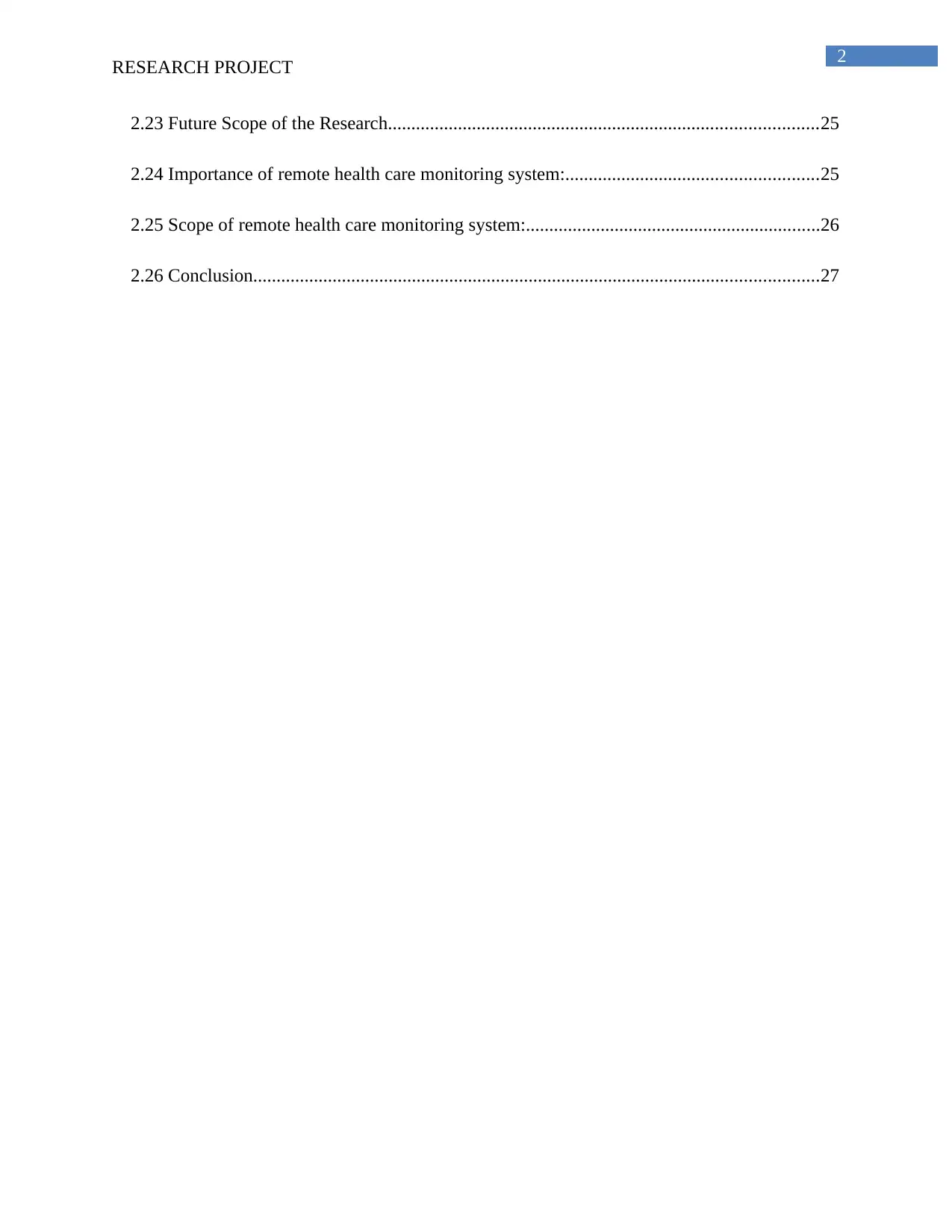
2
RESEARCH PROJECT
2.23 Future Scope of the Research............................................................................................25
2.24 Importance of remote health care monitoring system:......................................................25
2.25 Scope of remote health care monitoring system:...............................................................26
2.26 Conclusion.........................................................................................................................27
RESEARCH PROJECT
2.23 Future Scope of the Research............................................................................................25
2.24 Importance of remote health care monitoring system:......................................................25
2.25 Scope of remote health care monitoring system:...............................................................26
2.26 Conclusion.........................................................................................................................27
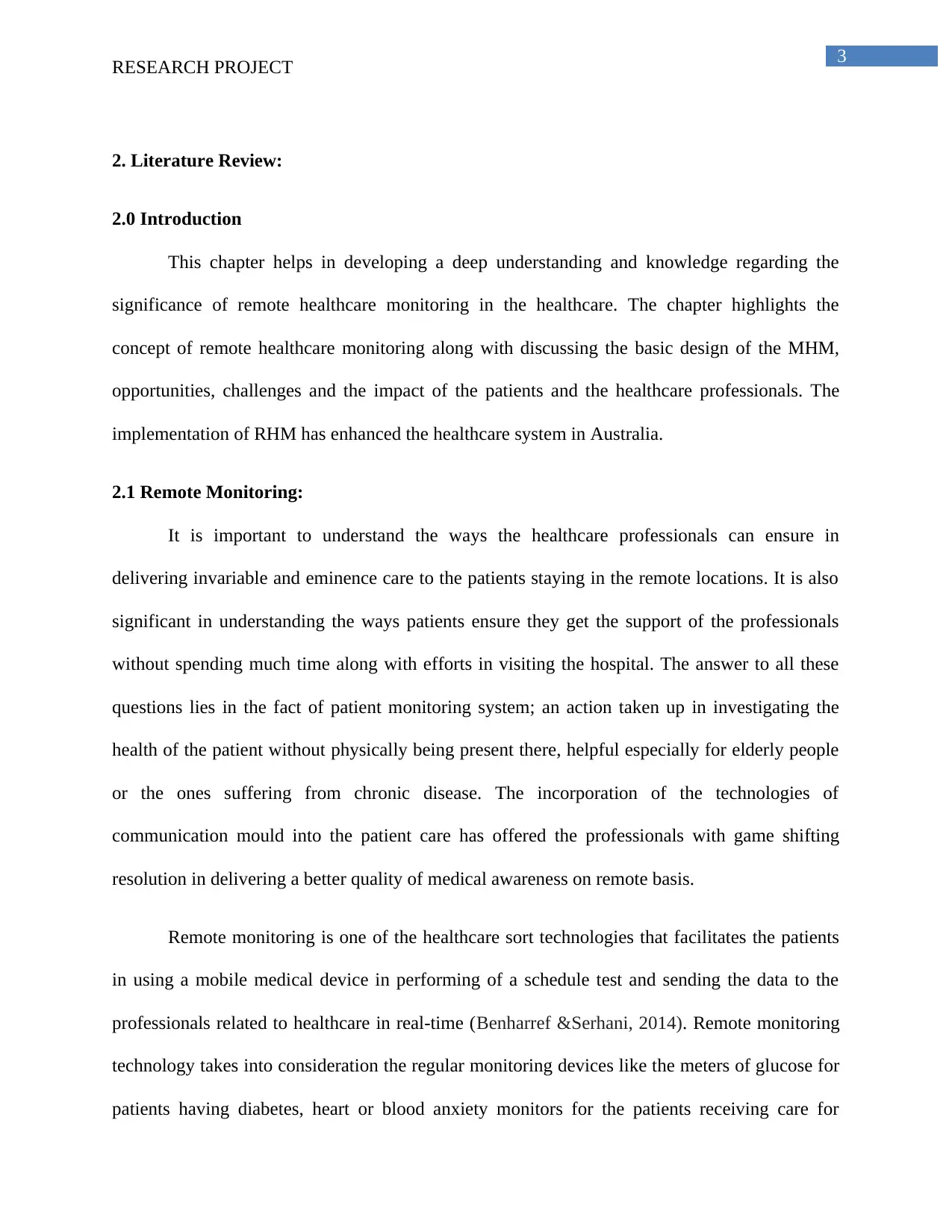
3
RESEARCH PROJECT
2. Literature Review:
2.0 Introduction
This chapter helps in developing a deep understanding and knowledge regarding the
significance of remote healthcare monitoring in the healthcare. The chapter highlights the
concept of remote healthcare monitoring along with discussing the basic design of the MHM,
opportunities, challenges and the impact of the patients and the healthcare professionals. The
implementation of RHM has enhanced the healthcare system in Australia.
2.1 Remote Monitoring:
It is important to understand the ways the healthcare professionals can ensure in
delivering invariable and eminence care to the patients staying in the remote locations. It is also
significant in understanding the ways patients ensure they get the support of the professionals
without spending much time along with efforts in visiting the hospital. The answer to all these
questions lies in the fact of patient monitoring system; an action taken up in investigating the
health of the patient without physically being present there, helpful especially for elderly people
or the ones suffering from chronic disease. The incorporation of the technologies of
communication mould into the patient care has offered the professionals with game shifting
resolution in delivering a better quality of medical awareness on remote basis.
Remote monitoring is one of the healthcare sort technologies that facilitates the patients
in using a mobile medical device in performing of a schedule test and sending the data to the
professionals related to healthcare in real-time (Benharref &Serhani, 2014). Remote monitoring
technology takes into consideration the regular monitoring devices like the meters of glucose for
patients having diabetes, heart or blood anxiety monitors for the patients receiving care for
RESEARCH PROJECT
2. Literature Review:
2.0 Introduction
This chapter helps in developing a deep understanding and knowledge regarding the
significance of remote healthcare monitoring in the healthcare. The chapter highlights the
concept of remote healthcare monitoring along with discussing the basic design of the MHM,
opportunities, challenges and the impact of the patients and the healthcare professionals. The
implementation of RHM has enhanced the healthcare system in Australia.
2.1 Remote Monitoring:
It is important to understand the ways the healthcare professionals can ensure in
delivering invariable and eminence care to the patients staying in the remote locations. It is also
significant in understanding the ways patients ensure they get the support of the professionals
without spending much time along with efforts in visiting the hospital. The answer to all these
questions lies in the fact of patient monitoring system; an action taken up in investigating the
health of the patient without physically being present there, helpful especially for elderly people
or the ones suffering from chronic disease. The incorporation of the technologies of
communication mould into the patient care has offered the professionals with game shifting
resolution in delivering a better quality of medical awareness on remote basis.
Remote monitoring is one of the healthcare sort technologies that facilitates the patients
in using a mobile medical device in performing of a schedule test and sending the data to the
professionals related to healthcare in real-time (Benharref &Serhani, 2014). Remote monitoring
technology takes into consideration the regular monitoring devices like the meters of glucose for
patients having diabetes, heart or blood anxiety monitors for the patients receiving care for
Secure Best Marks with AI Grader
Need help grading? Try our AI Grader for instant feedback on your assignments.
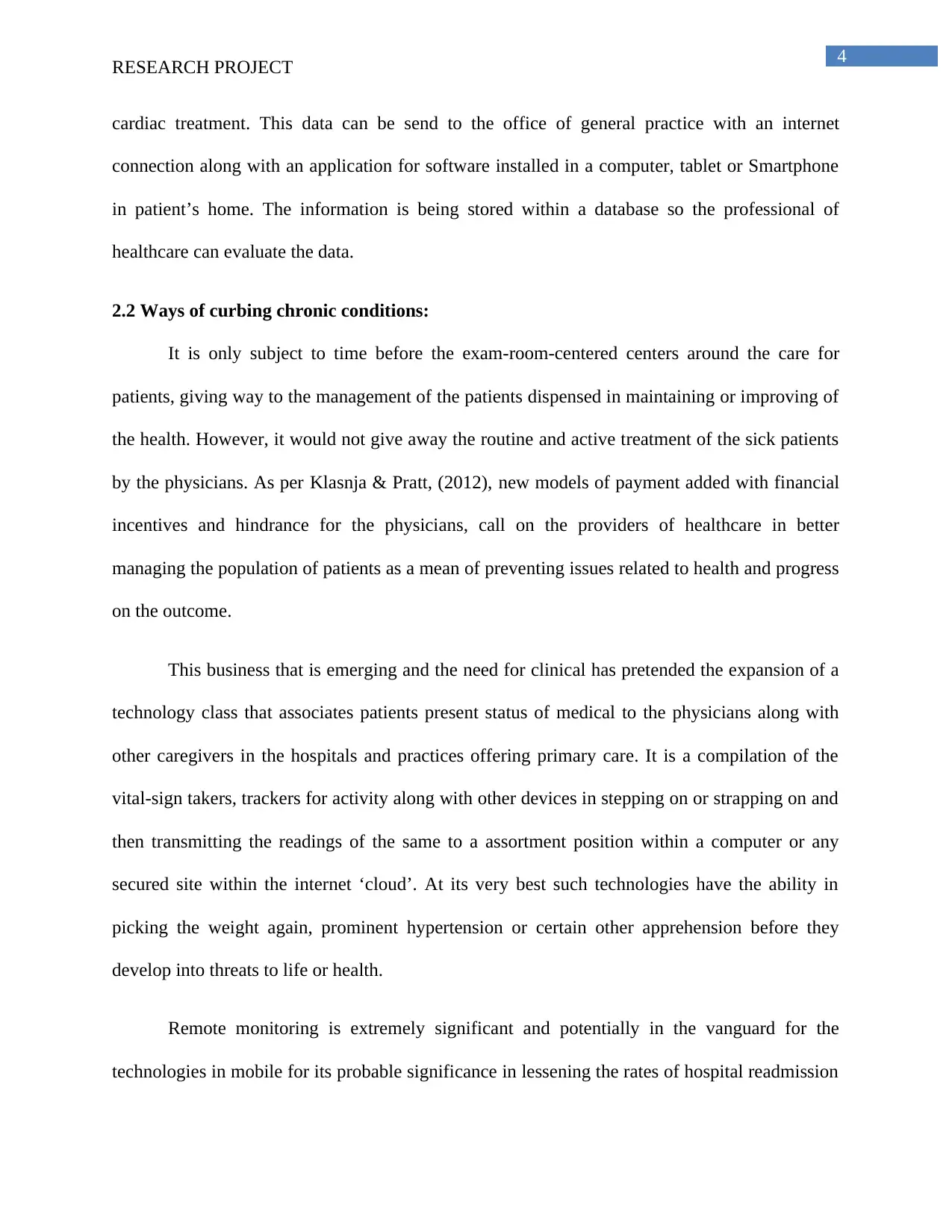
4
RESEARCH PROJECT
cardiac treatment. This data can be send to the office of general practice with an internet
connection along with an application for software installed in a computer, tablet or Smartphone
in patient’s home. The information is being stored within a database so the professional of
healthcare can evaluate the data.
2.2 Ways of curbing chronic conditions:
It is only subject to time before the exam-room-centered centers around the care for
patients, giving way to the management of the patients dispensed in maintaining or improving of
the health. However, it would not give away the routine and active treatment of the sick patients
by the physicians. As per Klasnja & Pratt, (2012), new models of payment added with financial
incentives and hindrance for the physicians, call on the providers of healthcare in better
managing the population of patients as a mean of preventing issues related to health and progress
on the outcome.
This business that is emerging and the need for clinical has pretended the expansion of a
technology class that associates patients present status of medical to the physicians along with
other caregivers in the hospitals and practices offering primary care. It is a compilation of the
vital-sign takers, trackers for activity along with other devices in stepping on or strapping on and
then transmitting the readings of the same to a assortment position within a computer or any
secured site within the internet ‘cloud’. At its very best such technologies have the ability in
picking the weight again, prominent hypertension or certain other apprehension before they
develop into threats to life or health.
Remote monitoring is extremely significant and potentially in the vanguard for the
technologies in mobile for its probable significance in lessening the rates of hospital readmission
RESEARCH PROJECT
cardiac treatment. This data can be send to the office of general practice with an internet
connection along with an application for software installed in a computer, tablet or Smartphone
in patient’s home. The information is being stored within a database so the professional of
healthcare can evaluate the data.
2.2 Ways of curbing chronic conditions:
It is only subject to time before the exam-room-centered centers around the care for
patients, giving way to the management of the patients dispensed in maintaining or improving of
the health. However, it would not give away the routine and active treatment of the sick patients
by the physicians. As per Klasnja & Pratt, (2012), new models of payment added with financial
incentives and hindrance for the physicians, call on the providers of healthcare in better
managing the population of patients as a mean of preventing issues related to health and progress
on the outcome.
This business that is emerging and the need for clinical has pretended the expansion of a
technology class that associates patients present status of medical to the physicians along with
other caregivers in the hospitals and practices offering primary care. It is a compilation of the
vital-sign takers, trackers for activity along with other devices in stepping on or strapping on and
then transmitting the readings of the same to a assortment position within a computer or any
secured site within the internet ‘cloud’. At its very best such technologies have the ability in
picking the weight again, prominent hypertension or certain other apprehension before they
develop into threats to life or health.
Remote monitoring is extremely significant and potentially in the vanguard for the
technologies in mobile for its probable significance in lessening the rates of hospital readmission

5
RESEARCH PROJECT
that sometimes becomes big headlines. Remote monitoring takes in keeping the patient in touch
with the physicians over a longer period of time outside the surroundings of acute-care so that
one does not have to wait for the disasters to take place in bringing the deteriorating condition to
the attention of the provider.
Patients want admittance to these sorts of remote monitoring technologies in improving
their health condition. A health patient survey conducted by the public relations agency Ruder
Finn found out that approximately 34 per cent of the patients need their physicians in having
more admittance to the remote monitoring technologies. Patients who are older require these sort
of technologies even more with the survey stating around 40 per cent of the older ones requiring
access to the technology that has the ability in alerting the physicians along with other caregivers
if there is any sort of emergency in health.
Under the present circumstances, establishment of the remote monitoring system and
being paid for the same vestiges a challenge, mainly for the independent practices of small and
solo nature. Physicians have already been tackling with and are besieged with a multitude of
technology systems that requires proper understanding and investing from the systems of
electronic health records along with the portals of the patients to the platforms for telemedicine
and social media.
Instituting of the remote monitoring, as stated by the experts would be requiring changes
in the ways medical practice has been conducting its business, might need joining a clinically
incorporated system of providers for scaling the process of monitoring in appropriate basis.
Physicians are required in developing fresh ways for interacting with the patients along with
instituting new procedures and tasks for the members of the staff in taking on this flood of data
RESEARCH PROJECT
that sometimes becomes big headlines. Remote monitoring takes in keeping the patient in touch
with the physicians over a longer period of time outside the surroundings of acute-care so that
one does not have to wait for the disasters to take place in bringing the deteriorating condition to
the attention of the provider.
Patients want admittance to these sorts of remote monitoring technologies in improving
their health condition. A health patient survey conducted by the public relations agency Ruder
Finn found out that approximately 34 per cent of the patients need their physicians in having
more admittance to the remote monitoring technologies. Patients who are older require these sort
of technologies even more with the survey stating around 40 per cent of the older ones requiring
access to the technology that has the ability in alerting the physicians along with other caregivers
if there is any sort of emergency in health.
Under the present circumstances, establishment of the remote monitoring system and
being paid for the same vestiges a challenge, mainly for the independent practices of small and
solo nature. Physicians have already been tackling with and are besieged with a multitude of
technology systems that requires proper understanding and investing from the systems of
electronic health records along with the portals of the patients to the platforms for telemedicine
and social media.
Instituting of the remote monitoring, as stated by the experts would be requiring changes
in the ways medical practice has been conducting its business, might need joining a clinically
incorporated system of providers for scaling the process of monitoring in appropriate basis.
Physicians are required in developing fresh ways for interacting with the patients along with
instituting new procedures and tasks for the members of the staff in taking on this flood of data
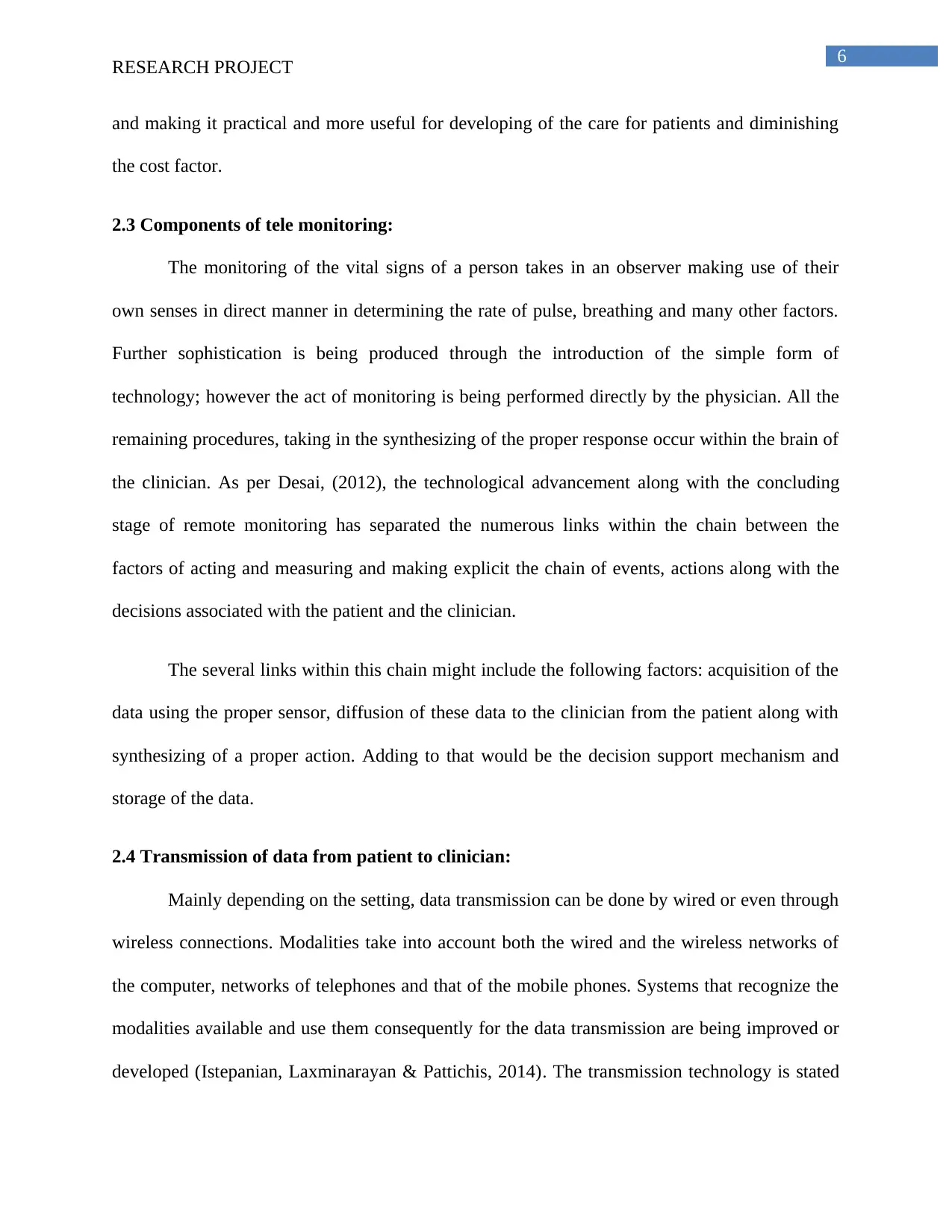
6
RESEARCH PROJECT
and making it practical and more useful for developing of the care for patients and diminishing
the cost factor.
2.3 Components of tele monitoring:
The monitoring of the vital signs of a person takes in an observer making use of their
own senses in direct manner in determining the rate of pulse, breathing and many other factors.
Further sophistication is being produced through the introduction of the simple form of
technology; however the act of monitoring is being performed directly by the physician. All the
remaining procedures, taking in the synthesizing of the proper response occur within the brain of
the clinician. As per Desai, (2012), the technological advancement along with the concluding
stage of remote monitoring has separated the numerous links within the chain between the
factors of acting and measuring and making explicit the chain of events, actions along with the
decisions associated with the patient and the clinician.
The several links within this chain might include the following factors: acquisition of the
data using the proper sensor, diffusion of these data to the clinician from the patient along with
synthesizing of a proper action. Adding to that would be the decision support mechanism and
storage of the data.
2.4 Transmission of data from patient to clinician:
Mainly depending on the setting, data transmission can be done by wired or even through
wireless connections. Modalities take into account both the wired and the wireless networks of
the computer, networks of telephones and that of the mobile phones. Systems that recognize the
modalities available and use them consequently for the data transmission are being improved or
developed (Istepanian, Laxminarayan & Pattichis, 2014). The transmission technology is stated
RESEARCH PROJECT
and making it practical and more useful for developing of the care for patients and diminishing
the cost factor.
2.3 Components of tele monitoring:
The monitoring of the vital signs of a person takes in an observer making use of their
own senses in direct manner in determining the rate of pulse, breathing and many other factors.
Further sophistication is being produced through the introduction of the simple form of
technology; however the act of monitoring is being performed directly by the physician. All the
remaining procedures, taking in the synthesizing of the proper response occur within the brain of
the clinician. As per Desai, (2012), the technological advancement along with the concluding
stage of remote monitoring has separated the numerous links within the chain between the
factors of acting and measuring and making explicit the chain of events, actions along with the
decisions associated with the patient and the clinician.
The several links within this chain might include the following factors: acquisition of the
data using the proper sensor, diffusion of these data to the clinician from the patient along with
synthesizing of a proper action. Adding to that would be the decision support mechanism and
storage of the data.
2.4 Transmission of data from patient to clinician:
Mainly depending on the setting, data transmission can be done by wired or even through
wireless connections. Modalities take into account both the wired and the wireless networks of
the computer, networks of telephones and that of the mobile phones. Systems that recognize the
modalities available and use them consequently for the data transmission are being improved or
developed (Istepanian, Laxminarayan & Pattichis, 2014). The transmission technology is stated
Paraphrase This Document
Need a fresh take? Get an instant paraphrase of this document with our AI Paraphraser
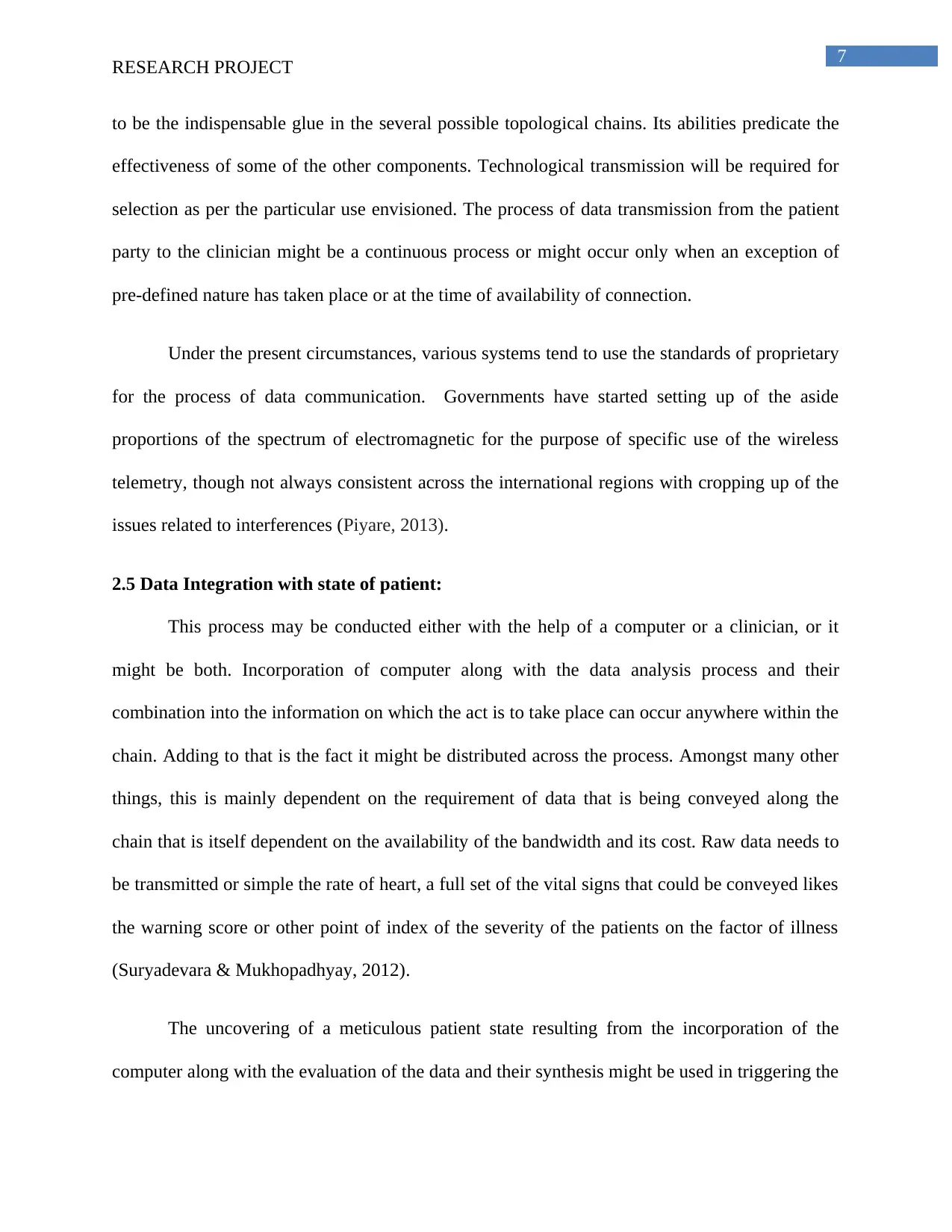
7
RESEARCH PROJECT
to be the indispensable glue in the several possible topological chains. Its abilities predicate the
effectiveness of some of the other components. Technological transmission will be required for
selection as per the particular use envisioned. The process of data transmission from the patient
party to the clinician might be a continuous process or might occur only when an exception of
pre-defined nature has taken place or at the time of availability of connection.
Under the present circumstances, various systems tend to use the standards of proprietary
for the process of data communication. Governments have started setting up of the aside
proportions of the spectrum of electromagnetic for the purpose of specific use of the wireless
telemetry, though not always consistent across the international regions with cropping up of the
issues related to interferences (Piyare, 2013).
2.5 Data Integration with state of patient:
This process may be conducted either with the help of a computer or a clinician, or it
might be both. Incorporation of computer along with the data analysis process and their
combination into the information on which the act is to take place can occur anywhere within the
chain. Adding to that is the fact it might be distributed across the process. Amongst many other
things, this is mainly dependent on the requirement of data that is being conveyed along the
chain that is itself dependent on the availability of the bandwidth and its cost. Raw data needs to
be transmitted or simple the rate of heart, a full set of the vital signs that could be conveyed likes
the warning score or other point of index of the severity of the patients on the factor of illness
(Suryadevara & Mukhopadhyay, 2012).
The uncovering of a meticulous patient state resulting from the incorporation of the
computer along with the evaluation of the data and their synthesis might be used in triggering the
RESEARCH PROJECT
to be the indispensable glue in the several possible topological chains. Its abilities predicate the
effectiveness of some of the other components. Technological transmission will be required for
selection as per the particular use envisioned. The process of data transmission from the patient
party to the clinician might be a continuous process or might occur only when an exception of
pre-defined nature has taken place or at the time of availability of connection.
Under the present circumstances, various systems tend to use the standards of proprietary
for the process of data communication. Governments have started setting up of the aside
proportions of the spectrum of electromagnetic for the purpose of specific use of the wireless
telemetry, though not always consistent across the international regions with cropping up of the
issues related to interferences (Piyare, 2013).
2.5 Data Integration with state of patient:
This process may be conducted either with the help of a computer or a clinician, or it
might be both. Incorporation of computer along with the data analysis process and their
combination into the information on which the act is to take place can occur anywhere within the
chain. Adding to that is the fact it might be distributed across the process. Amongst many other
things, this is mainly dependent on the requirement of data that is being conveyed along the
chain that is itself dependent on the availability of the bandwidth and its cost. Raw data needs to
be transmitted or simple the rate of heart, a full set of the vital signs that could be conveyed likes
the warning score or other point of index of the severity of the patients on the factor of illness
(Suryadevara & Mukhopadhyay, 2012).
The uncovering of a meticulous patient state resulting from the incorporation of the
computer along with the evaluation of the data and their synthesis might be used in triggering the
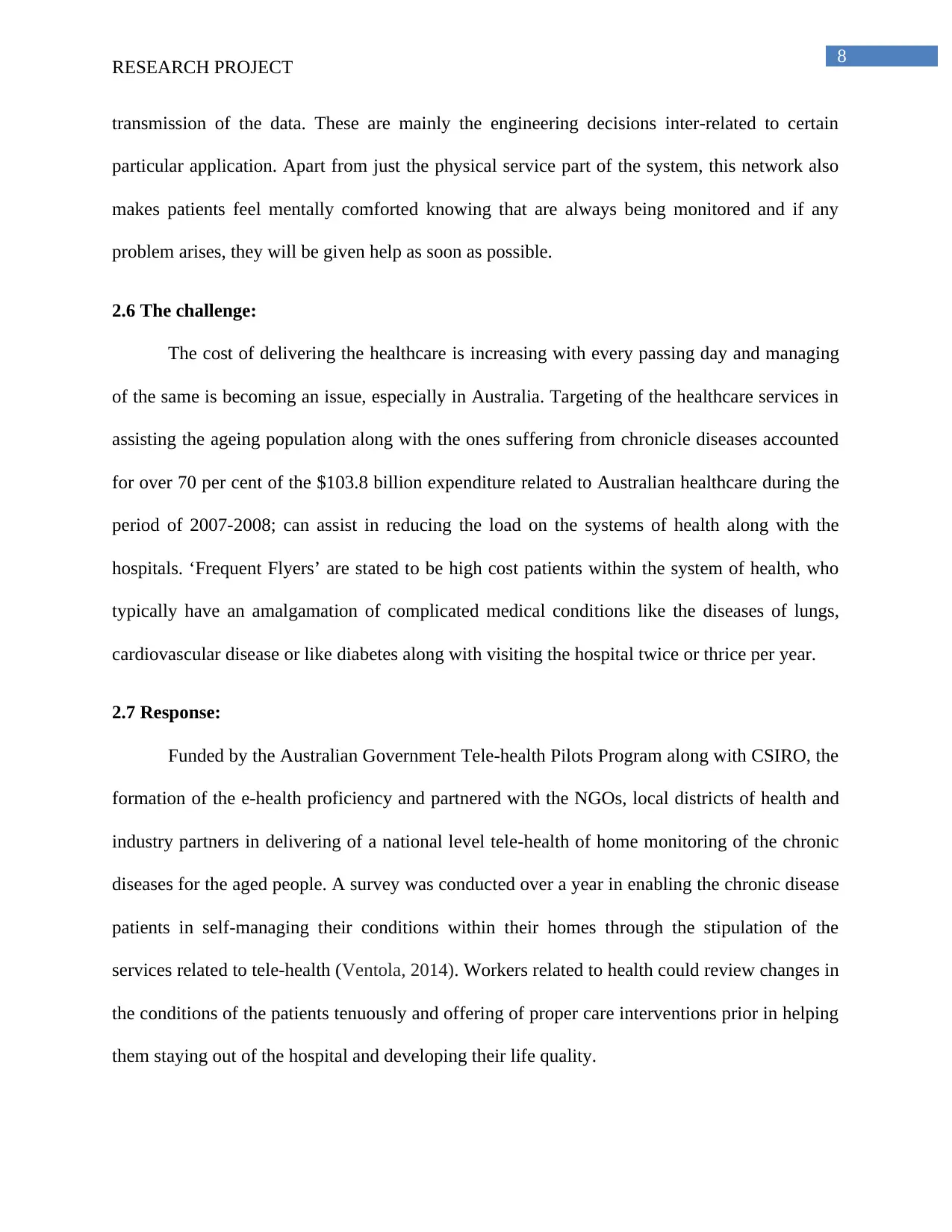
8
RESEARCH PROJECT
transmission of the data. These are mainly the engineering decisions inter-related to certain
particular application. Apart from just the physical service part of the system, this network also
makes patients feel mentally comforted knowing that are always being monitored and if any
problem arises, they will be given help as soon as possible.
2.6 The challenge:
The cost of delivering the healthcare is increasing with every passing day and managing
of the same is becoming an issue, especially in Australia. Targeting of the healthcare services in
assisting the ageing population along with the ones suffering from chronicle diseases accounted
for over 70 per cent of the $103.8 billion expenditure related to Australian healthcare during the
period of 2007-2008; can assist in reducing the load on the systems of health along with the
hospitals. ‘Frequent Flyers’ are stated to be high cost patients within the system of health, who
typically have an amalgamation of complicated medical conditions like the diseases of lungs,
cardiovascular disease or like diabetes along with visiting the hospital twice or thrice per year.
2.7 Response:
Funded by the Australian Government Tele-health Pilots Program along with CSIRO, the
formation of the e-health proficiency and partnered with the NGOs, local districts of health and
industry partners in delivering of a national level tele-health of home monitoring of the chronic
diseases for the aged people. A survey was conducted over a year in enabling the chronic disease
patients in self-managing their conditions within their homes through the stipulation of the
services related to tele-health (Ventola, 2014). Workers related to health could review changes in
the conditions of the patients tenuously and offering of proper care interventions prior in helping
them staying out of the hospital and developing their life quality.
RESEARCH PROJECT
transmission of the data. These are mainly the engineering decisions inter-related to certain
particular application. Apart from just the physical service part of the system, this network also
makes patients feel mentally comforted knowing that are always being monitored and if any
problem arises, they will be given help as soon as possible.
2.6 The challenge:
The cost of delivering the healthcare is increasing with every passing day and managing
of the same is becoming an issue, especially in Australia. Targeting of the healthcare services in
assisting the ageing population along with the ones suffering from chronicle diseases accounted
for over 70 per cent of the $103.8 billion expenditure related to Australian healthcare during the
period of 2007-2008; can assist in reducing the load on the systems of health along with the
hospitals. ‘Frequent Flyers’ are stated to be high cost patients within the system of health, who
typically have an amalgamation of complicated medical conditions like the diseases of lungs,
cardiovascular disease or like diabetes along with visiting the hospital twice or thrice per year.
2.7 Response:
Funded by the Australian Government Tele-health Pilots Program along with CSIRO, the
formation of the e-health proficiency and partnered with the NGOs, local districts of health and
industry partners in delivering of a national level tele-health of home monitoring of the chronic
diseases for the aged people. A survey was conducted over a year in enabling the chronic disease
patients in self-managing their conditions within their homes through the stipulation of the
services related to tele-health (Ventola, 2014). Workers related to health could review changes in
the conditions of the patients tenuously and offering of proper care interventions prior in helping
them staying out of the hospital and developing their life quality.
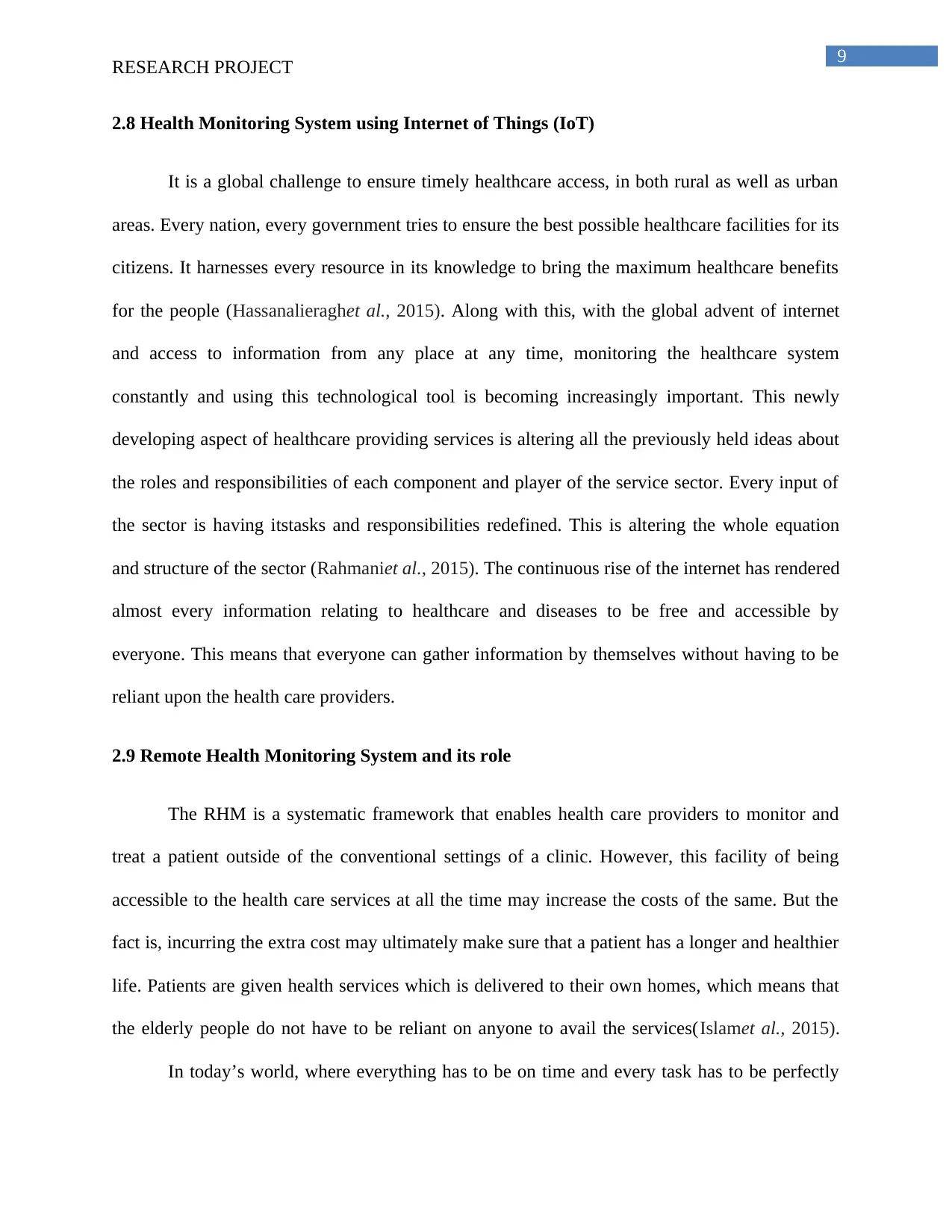
9
RESEARCH PROJECT
2.8 Health Monitoring System using Internet of Things (IoT)
It is a global challenge to ensure timely healthcare access, in both rural as well as urban
areas. Every nation, every government tries to ensure the best possible healthcare facilities for its
citizens. It harnesses every resource in its knowledge to bring the maximum healthcare benefits
for the people (Hassanalieraghet al., 2015). Along with this, with the global advent of internet
and access to information from any place at any time, monitoring the healthcare system
constantly and using this technological tool is becoming increasingly important. This newly
developing aspect of healthcare providing services is altering all the previously held ideas about
the roles and responsibilities of each component and player of the service sector. Every input of
the sector is having itstasks and responsibilities redefined. This is altering the whole equation
and structure of the sector (Rahmaniet al., 2015). The continuous rise of the internet has rendered
almost every information relating to healthcare and diseases to be free and accessible by
everyone. This means that everyone can gather information by themselves without having to be
reliant upon the health care providers.
2.9 Remote Health Monitoring System and its role
The RHM is a systematic framework that enables health care providers to monitor and
treat a patient outside of the conventional settings of a clinic. However, this facility of being
accessible to the health care services at all the time may increase the costs of the same. But the
fact is, incurring the extra cost may ultimately make sure that a patient has a longer and healthier
life. Patients are given health services which is delivered to their own homes, which means that
the elderly people do not have to be reliant on anyone to avail the services(Islamet al., 2015).
In today’s world, where everything has to be on time and every task has to be perfectly
RESEARCH PROJECT
2.8 Health Monitoring System using Internet of Things (IoT)
It is a global challenge to ensure timely healthcare access, in both rural as well as urban
areas. Every nation, every government tries to ensure the best possible healthcare facilities for its
citizens. It harnesses every resource in its knowledge to bring the maximum healthcare benefits
for the people (Hassanalieraghet al., 2015). Along with this, with the global advent of internet
and access to information from any place at any time, monitoring the healthcare system
constantly and using this technological tool is becoming increasingly important. This newly
developing aspect of healthcare providing services is altering all the previously held ideas about
the roles and responsibilities of each component and player of the service sector. Every input of
the sector is having itstasks and responsibilities redefined. This is altering the whole equation
and structure of the sector (Rahmaniet al., 2015). The continuous rise of the internet has rendered
almost every information relating to healthcare and diseases to be free and accessible by
everyone. This means that everyone can gather information by themselves without having to be
reliant upon the health care providers.
2.9 Remote Health Monitoring System and its role
The RHM is a systematic framework that enables health care providers to monitor and
treat a patient outside of the conventional settings of a clinic. However, this facility of being
accessible to the health care services at all the time may increase the costs of the same. But the
fact is, incurring the extra cost may ultimately make sure that a patient has a longer and healthier
life. Patients are given health services which is delivered to their own homes, which means that
the elderly people do not have to be reliant on anyone to avail the services(Islamet al., 2015).
In today’s world, where everything has to be on time and every task has to be perfectly
Secure Best Marks with AI Grader
Need help grading? Try our AI Grader for instant feedback on your assignments.

10
RESEARCH PROJECT
executed as soon as possible, most people do not have the time for check-ups to the doctor or
visit clinics regularly(Rahmaniet al., 2015). Remote Health Monitoring aids in this aspect
tremendously. Many rural areas, where transportation and regular communication is a problem,
can be benefited by the system as it alerts the health care professionals about any problem that
arises.
2.10 Reasons to incorporate internet in the RHM
There are numerous benefits to including internet use in the RHM system. The most
important aspect of this incorporation is the fact that this increases efficiency. Satellite based
system and a tele health computing system can notify the physicians and other health care
professionals if any fluctuation in the health condition of any patient is noticed
(Baig&Gholamhosseini, 2013). This enables the health care personnel to act promptly and
deliver the health services without much hassle. Any kind of monitoring software or app can be
installed on the patient’s computer, mobile phone or tablet, that would keep track of the patient’s
health conditions and send notifications if need be. Even if the patient is not suffering from any
sudden or critical problem at any given point of time, the software sends data to the health care
providers on a regular basis which allows the health consultant of the patient to make out a trend
from the collected data. For patients who are chronically ill and cannot travel long distances,
being monitored remotely decreases the number of clinic visits and this is a very important
advantage of the system.
2.11 Wearable sensors
One of the most popular remote monitoring systems worldwide are the wearable sensors
that have gained increased demand over the recent years. Many of these devices are
RESEARCH PROJECT
executed as soon as possible, most people do not have the time for check-ups to the doctor or
visit clinics regularly(Rahmaniet al., 2015). Remote Health Monitoring aids in this aspect
tremendously. Many rural areas, where transportation and regular communication is a problem,
can be benefited by the system as it alerts the health care professionals about any problem that
arises.
2.10 Reasons to incorporate internet in the RHM
There are numerous benefits to including internet use in the RHM system. The most
important aspect of this incorporation is the fact that this increases efficiency. Satellite based
system and a tele health computing system can notify the physicians and other health care
professionals if any fluctuation in the health condition of any patient is noticed
(Baig&Gholamhosseini, 2013). This enables the health care personnel to act promptly and
deliver the health services without much hassle. Any kind of monitoring software or app can be
installed on the patient’s computer, mobile phone or tablet, that would keep track of the patient’s
health conditions and send notifications if need be. Even if the patient is not suffering from any
sudden or critical problem at any given point of time, the software sends data to the health care
providers on a regular basis which allows the health consultant of the patient to make out a trend
from the collected data. For patients who are chronically ill and cannot travel long distances,
being monitored remotely decreases the number of clinic visits and this is a very important
advantage of the system.
2.11 Wearable sensors
One of the most popular remote monitoring systems worldwide are the wearable sensors
that have gained increased demand over the recent years. Many of these devices are
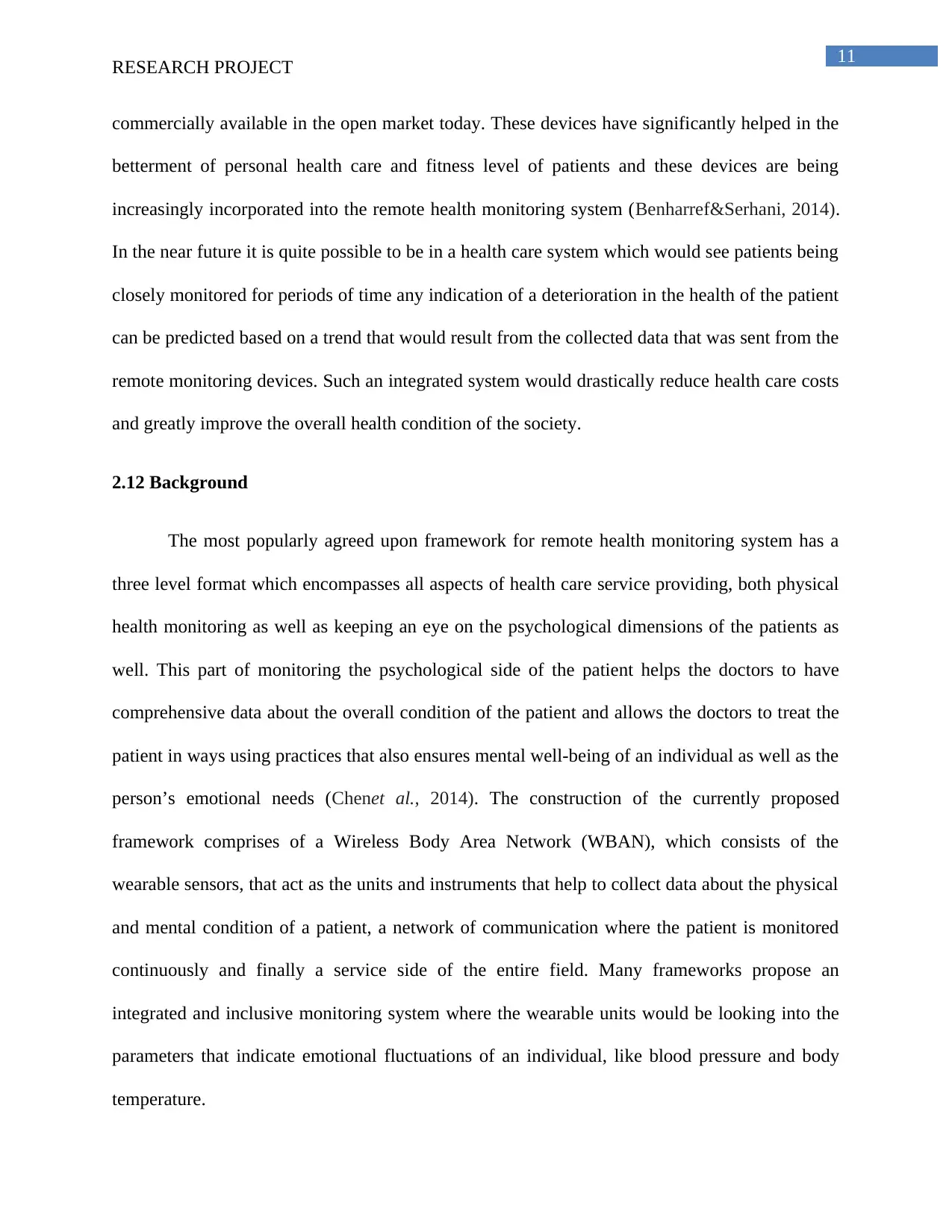
11
RESEARCH PROJECT
commercially available in the open market today. These devices have significantly helped in the
betterment of personal health care and fitness level of patients and these devices are being
increasingly incorporated into the remote health monitoring system (Benharref&Serhani, 2014).
In the near future it is quite possible to be in a health care system which would see patients being
closely monitored for periods of time any indication of a deterioration in the health of the patient
can be predicted based on a trend that would result from the collected data that was sent from the
remote monitoring devices. Such an integrated system would drastically reduce health care costs
and greatly improve the overall health condition of the society.
2.12 Background
The most popularly agreed upon framework for remote health monitoring system has a
three level format which encompasses all aspects of health care service providing, both physical
health monitoring as well as keeping an eye on the psychological dimensions of the patients as
well. This part of monitoring the psychological side of the patient helps the doctors to have
comprehensive data about the overall condition of the patient and allows the doctors to treat the
patient in ways using practices that also ensures mental well-being of an individual as well as the
person’s emotional needs (Chenet al., 2014). The construction of the currently proposed
framework comprises of a Wireless Body Area Network (WBAN), which consists of the
wearable sensors, that act as the units and instruments that help to collect data about the physical
and mental condition of a patient, a network of communication where the patient is monitored
continuously and finally a service side of the entire field. Many frameworks propose an
integrated and inclusive monitoring system where the wearable units would be looking into the
parameters that indicate emotional fluctuations of an individual, like blood pressure and body
temperature.
RESEARCH PROJECT
commercially available in the open market today. These devices have significantly helped in the
betterment of personal health care and fitness level of patients and these devices are being
increasingly incorporated into the remote health monitoring system (Benharref&Serhani, 2014).
In the near future it is quite possible to be in a health care system which would see patients being
closely monitored for periods of time any indication of a deterioration in the health of the patient
can be predicted based on a trend that would result from the collected data that was sent from the
remote monitoring devices. Such an integrated system would drastically reduce health care costs
and greatly improve the overall health condition of the society.
2.12 Background
The most popularly agreed upon framework for remote health monitoring system has a
three level format which encompasses all aspects of health care service providing, both physical
health monitoring as well as keeping an eye on the psychological dimensions of the patients as
well. This part of monitoring the psychological side of the patient helps the doctors to have
comprehensive data about the overall condition of the patient and allows the doctors to treat the
patient in ways using practices that also ensures mental well-being of an individual as well as the
person’s emotional needs (Chenet al., 2014). The construction of the currently proposed
framework comprises of a Wireless Body Area Network (WBAN), which consists of the
wearable sensors, that act as the units and instruments that help to collect data about the physical
and mental condition of a patient, a network of communication where the patient is monitored
continuously and finally a service side of the entire field. Many frameworks propose an
integrated and inclusive monitoring system where the wearable units would be looking into the
parameters that indicate emotional fluctuations of an individual, like blood pressure and body
temperature.
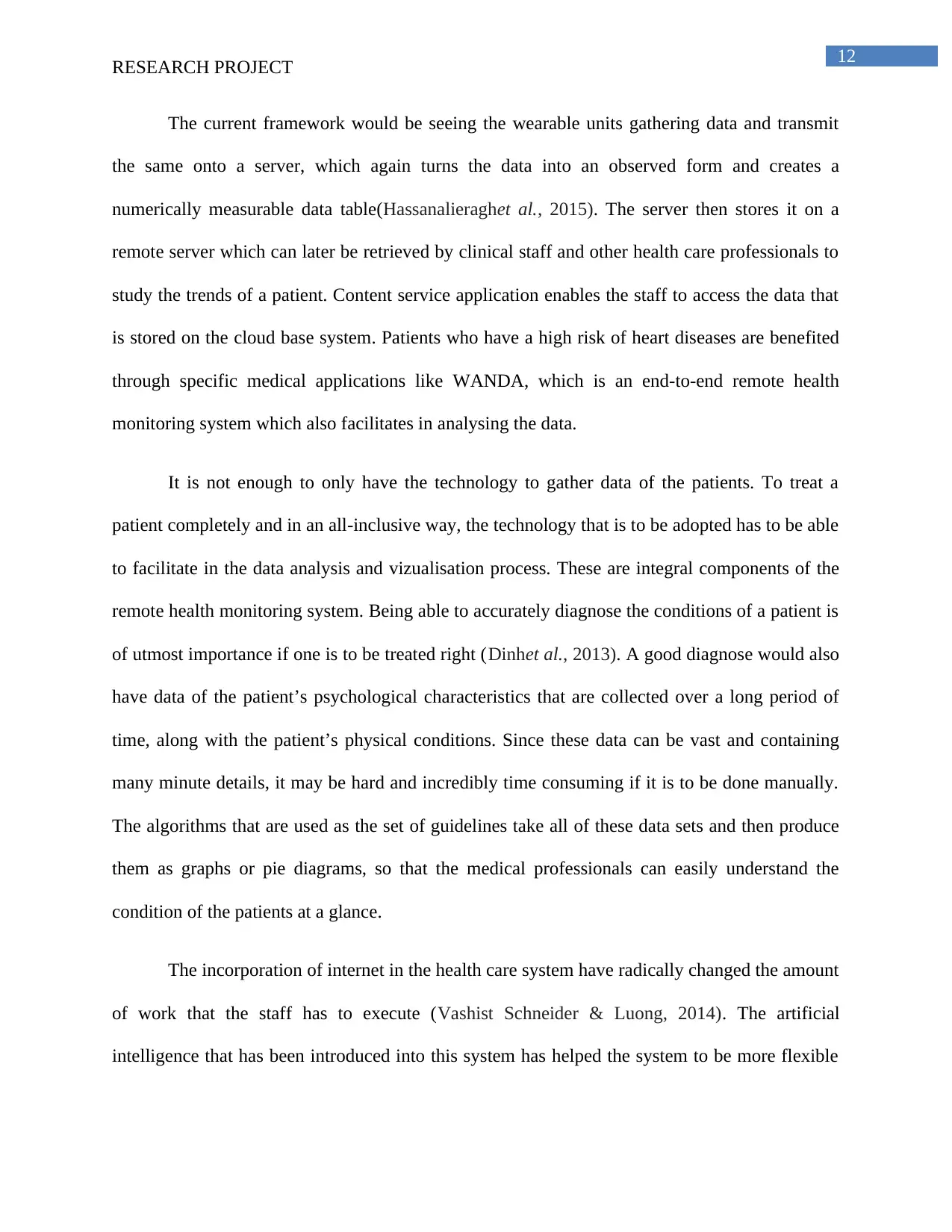
12
RESEARCH PROJECT
The current framework would be seeing the wearable units gathering data and transmit
the same onto a server, which again turns the data into an observed form and creates a
numerically measurable data table(Hassanalieraghet al., 2015). The server then stores it on a
remote server which can later be retrieved by clinical staff and other health care professionals to
study the trends of a patient. Content service application enables the staff to access the data that
is stored on the cloud base system. Patients who have a high risk of heart diseases are benefited
through specific medical applications like WANDA, which is an end-to-end remote health
monitoring system which also facilitates in analysing the data.
It is not enough to only have the technology to gather data of the patients. To treat a
patient completely and in an all-inclusive way, the technology that is to be adopted has to be able
to facilitate in the data analysis and vizualisation process. These are integral components of the
remote health monitoring system. Being able to accurately diagnose the conditions of a patient is
of utmost importance if one is to be treated right (Dinhet al., 2013). A good diagnose would also
have data of the patient’s psychological characteristics that are collected over a long period of
time, along with the patient’s physical conditions. Since these data can be vast and containing
many minute details, it may be hard and incredibly time consuming if it is to be done manually.
The algorithms that are used as the set of guidelines take all of these data sets and then produce
them as graphs or pie diagrams, so that the medical professionals can easily understand the
condition of the patients at a glance.
The incorporation of internet in the health care system have radically changed the amount
of work that the staff has to execute (Vashist Schneider & Luong, 2014). The artificial
intelligence that has been introduced into this system has helped the system to be more flexible
RESEARCH PROJECT
The current framework would be seeing the wearable units gathering data and transmit
the same onto a server, which again turns the data into an observed form and creates a
numerically measurable data table(Hassanalieraghet al., 2015). The server then stores it on a
remote server which can later be retrieved by clinical staff and other health care professionals to
study the trends of a patient. Content service application enables the staff to access the data that
is stored on the cloud base system. Patients who have a high risk of heart diseases are benefited
through specific medical applications like WANDA, which is an end-to-end remote health
monitoring system which also facilitates in analysing the data.
It is not enough to only have the technology to gather data of the patients. To treat a
patient completely and in an all-inclusive way, the technology that is to be adopted has to be able
to facilitate in the data analysis and vizualisation process. These are integral components of the
remote health monitoring system. Being able to accurately diagnose the conditions of a patient is
of utmost importance if one is to be treated right (Dinhet al., 2013). A good diagnose would also
have data of the patient’s psychological characteristics that are collected over a long period of
time, along with the patient’s physical conditions. Since these data can be vast and containing
many minute details, it may be hard and incredibly time consuming if it is to be done manually.
The algorithms that are used as the set of guidelines take all of these data sets and then produce
them as graphs or pie diagrams, so that the medical professionals can easily understand the
condition of the patients at a glance.
The incorporation of internet in the health care system have radically changed the amount
of work that the staff has to execute (Vashist Schneider & Luong, 2014). The artificial
intelligence that has been introduced into this system has helped the system to be more flexible
Paraphrase This Document
Need a fresh take? Get an instant paraphrase of this document with our AI Paraphraser
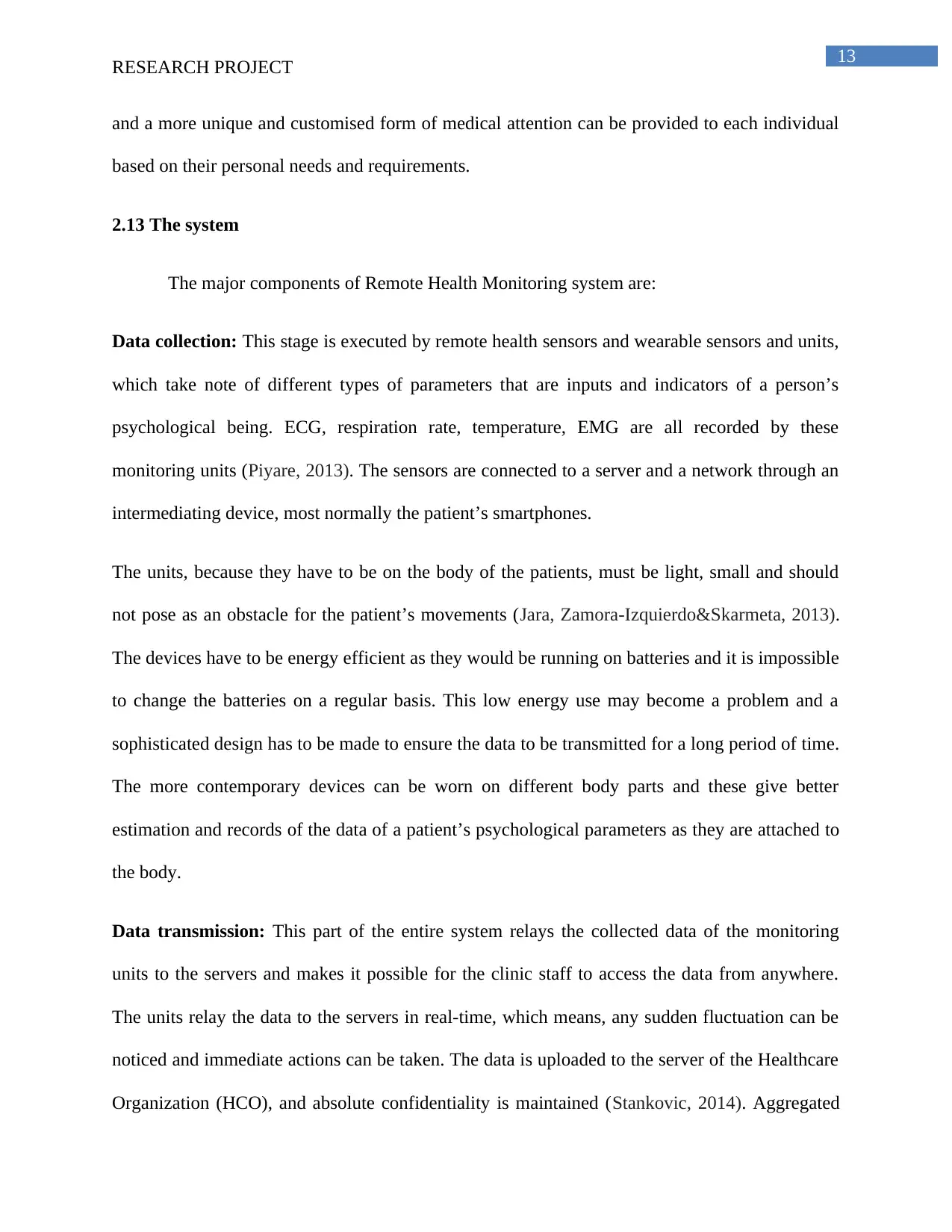
13
RESEARCH PROJECT
and a more unique and customised form of medical attention can be provided to each individual
based on their personal needs and requirements.
2.13 The system
The major components of Remote Health Monitoring system are:
Data collection: This stage is executed by remote health sensors and wearable sensors and units,
which take note of different types of parameters that are inputs and indicators of a person’s
psychological being. ECG, respiration rate, temperature, EMG are all recorded by these
monitoring units (Piyare, 2013). The sensors are connected to a server and a network through an
intermediating device, most normally the patient’s smartphones.
The units, because they have to be on the body of the patients, must be light, small and should
not pose as an obstacle for the patient’s movements (Jara, Zamora-Izquierdo&Skarmeta, 2013).
The devices have to be energy efficient as they would be running on batteries and it is impossible
to change the batteries on a regular basis. This low energy use may become a problem and a
sophisticated design has to be made to ensure the data to be transmitted for a long period of time.
The more contemporary devices can be worn on different body parts and these give better
estimation and records of the data of a patient’s psychological parameters as they are attached to
the body.
Data transmission: This part of the entire system relays the collected data of the monitoring
units to the servers and makes it possible for the clinic staff to access the data from anywhere.
The units relay the data to the servers in real-time, which means, any sudden fluctuation can be
noticed and immediate actions can be taken. The data is uploaded to the server of the Healthcare
Organization (HCO), and absolute confidentiality is maintained (Stankovic, 2014). Aggregated
RESEARCH PROJECT
and a more unique and customised form of medical attention can be provided to each individual
based on their personal needs and requirements.
2.13 The system
The major components of Remote Health Monitoring system are:
Data collection: This stage is executed by remote health sensors and wearable sensors and units,
which take note of different types of parameters that are inputs and indicators of a person’s
psychological being. ECG, respiration rate, temperature, EMG are all recorded by these
monitoring units (Piyare, 2013). The sensors are connected to a server and a network through an
intermediating device, most normally the patient’s smartphones.
The units, because they have to be on the body of the patients, must be light, small and should
not pose as an obstacle for the patient’s movements (Jara, Zamora-Izquierdo&Skarmeta, 2013).
The devices have to be energy efficient as they would be running on batteries and it is impossible
to change the batteries on a regular basis. This low energy use may become a problem and a
sophisticated design has to be made to ensure the data to be transmitted for a long period of time.
The more contemporary devices can be worn on different body parts and these give better
estimation and records of the data of a patient’s psychological parameters as they are attached to
the body.
Data transmission: This part of the entire system relays the collected data of the monitoring
units to the servers and makes it possible for the clinic staff to access the data from anywhere.
The units relay the data to the servers in real-time, which means, any sudden fluctuation can be
noticed and immediate actions can be taken. The data is uploaded to the server of the Healthcare
Organization (HCO), and absolute confidentiality is maintained (Stankovic, 2014). Aggregated
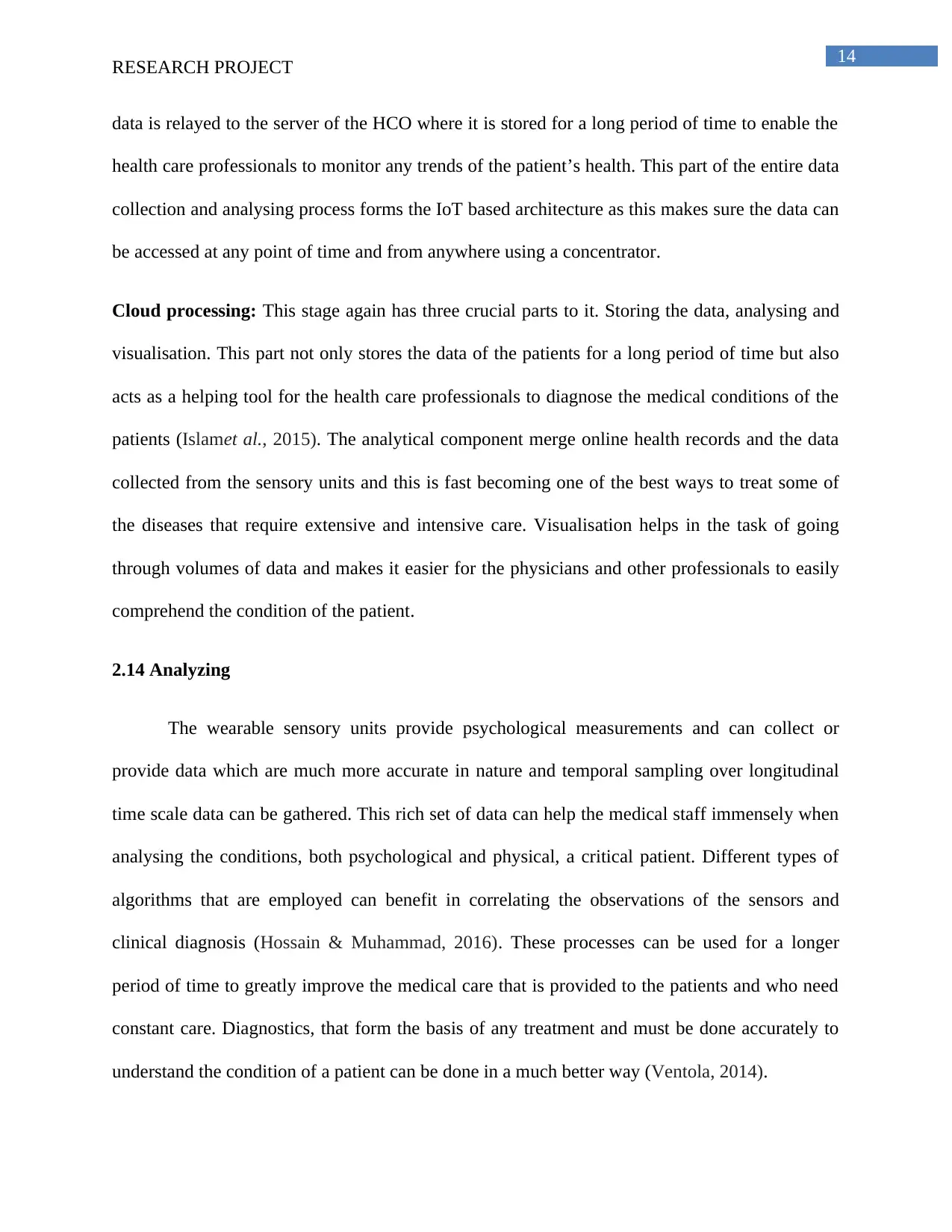
14
RESEARCH PROJECT
data is relayed to the server of the HCO where it is stored for a long period of time to enable the
health care professionals to monitor any trends of the patient’s health. This part of the entire data
collection and analysing process forms the IoT based architecture as this makes sure the data can
be accessed at any point of time and from anywhere using a concentrator.
Cloud processing: This stage again has three crucial parts to it. Storing the data, analysing and
visualisation. This part not only stores the data of the patients for a long period of time but also
acts as a helping tool for the health care professionals to diagnose the medical conditions of the
patients (Islamet al., 2015). The analytical component merge online health records and the data
collected from the sensory units and this is fast becoming one of the best ways to treat some of
the diseases that require extensive and intensive care. Visualisation helps in the task of going
through volumes of data and makes it easier for the physicians and other professionals to easily
comprehend the condition of the patient.
2.14 Analyzing
The wearable sensory units provide psychological measurements and can collect or
provide data which are much more accurate in nature and temporal sampling over longitudinal
time scale data can be gathered. This rich set of data can help the medical staff immensely when
analysing the conditions, both psychological and physical, a critical patient. Different types of
algorithms that are employed can benefit in correlating the observations of the sensors and
clinical diagnosis (Hossain & Muhammad, 2016). These processes can be used for a longer
period of time to greatly improve the medical care that is provided to the patients and who need
constant care. Diagnostics, that form the basis of any treatment and must be done accurately to
understand the condition of a patient can be done in a much better way (Ventola, 2014).
RESEARCH PROJECT
data is relayed to the server of the HCO where it is stored for a long period of time to enable the
health care professionals to monitor any trends of the patient’s health. This part of the entire data
collection and analysing process forms the IoT based architecture as this makes sure the data can
be accessed at any point of time and from anywhere using a concentrator.
Cloud processing: This stage again has three crucial parts to it. Storing the data, analysing and
visualisation. This part not only stores the data of the patients for a long period of time but also
acts as a helping tool for the health care professionals to diagnose the medical conditions of the
patients (Islamet al., 2015). The analytical component merge online health records and the data
collected from the sensory units and this is fast becoming one of the best ways to treat some of
the diseases that require extensive and intensive care. Visualisation helps in the task of going
through volumes of data and makes it easier for the physicians and other professionals to easily
comprehend the condition of the patient.
2.14 Analyzing
The wearable sensory units provide psychological measurements and can collect or
provide data which are much more accurate in nature and temporal sampling over longitudinal
time scale data can be gathered. This rich set of data can help the medical staff immensely when
analysing the conditions, both psychological and physical, a critical patient. Different types of
algorithms that are employed can benefit in correlating the observations of the sensors and
clinical diagnosis (Hossain & Muhammad, 2016). These processes can be used for a longer
period of time to greatly improve the medical care that is provided to the patients and who need
constant care. Diagnostics, that form the basis of any treatment and must be done accurately to
understand the condition of a patient can be done in a much better way (Ventola, 2014).
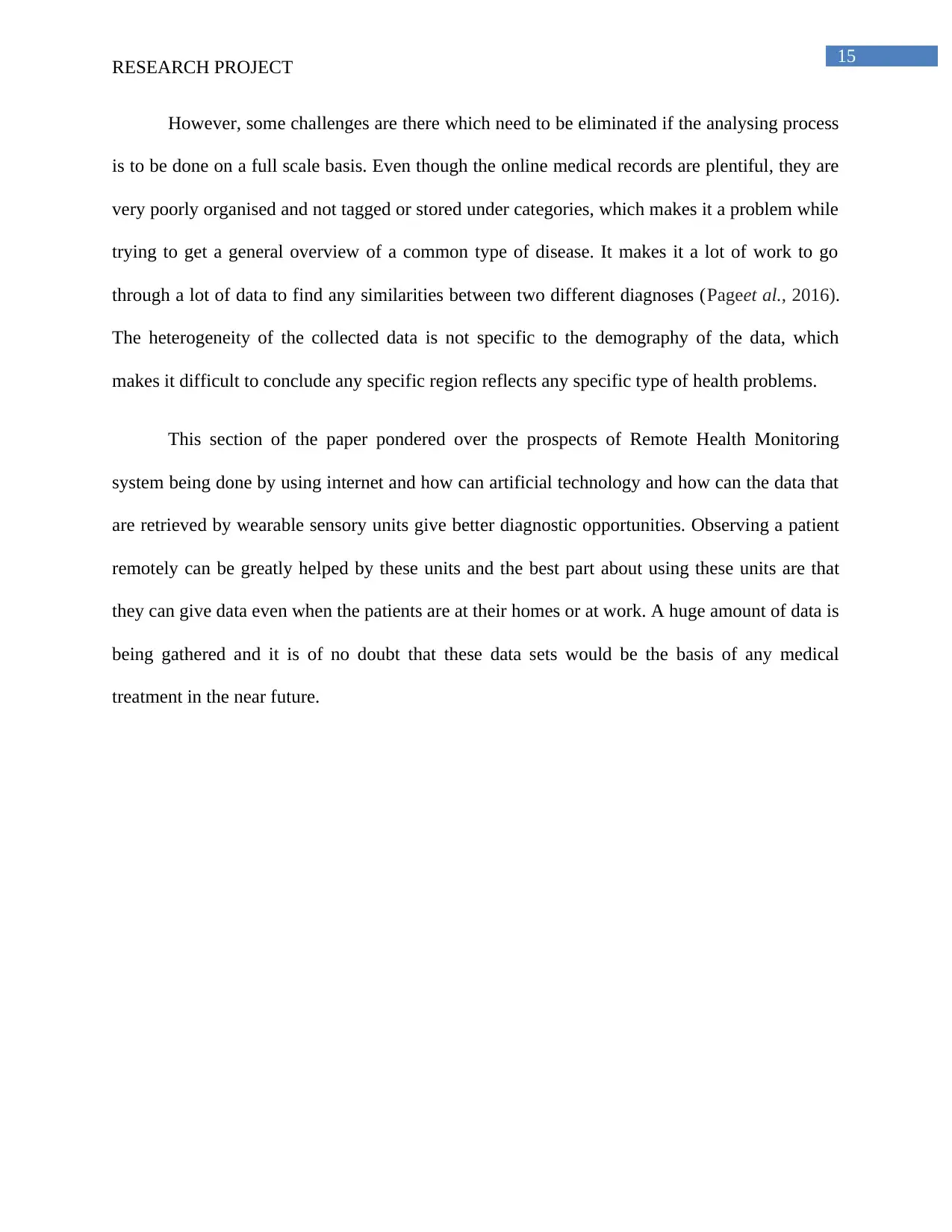
15
RESEARCH PROJECT
However, some challenges are there which need to be eliminated if the analysing process
is to be done on a full scale basis. Even though the online medical records are plentiful, they are
very poorly organised and not tagged or stored under categories, which makes it a problem while
trying to get a general overview of a common type of disease. It makes it a lot of work to go
through a lot of data to find any similarities between two different diagnoses (Pageet al., 2016).
The heterogeneity of the collected data is not specific to the demography of the data, which
makes it difficult to conclude any specific region reflects any specific type of health problems.
This section of the paper pondered over the prospects of Remote Health Monitoring
system being done by using internet and how can artificial technology and how can the data that
are retrieved by wearable sensory units give better diagnostic opportunities. Observing a patient
remotely can be greatly helped by these units and the best part about using these units are that
they can give data even when the patients are at their homes or at work. A huge amount of data is
being gathered and it is of no doubt that these data sets would be the basis of any medical
treatment in the near future.
RESEARCH PROJECT
However, some challenges are there which need to be eliminated if the analysing process
is to be done on a full scale basis. Even though the online medical records are plentiful, they are
very poorly organised and not tagged or stored under categories, which makes it a problem while
trying to get a general overview of a common type of disease. It makes it a lot of work to go
through a lot of data to find any similarities between two different diagnoses (Pageet al., 2016).
The heterogeneity of the collected data is not specific to the demography of the data, which
makes it difficult to conclude any specific region reflects any specific type of health problems.
This section of the paper pondered over the prospects of Remote Health Monitoring
system being done by using internet and how can artificial technology and how can the data that
are retrieved by wearable sensory units give better diagnostic opportunities. Observing a patient
remotely can be greatly helped by these units and the best part about using these units are that
they can give data even when the patients are at their homes or at work. A huge amount of data is
being gathered and it is of no doubt that these data sets would be the basis of any medical
treatment in the near future.
Secure Best Marks with AI Grader
Need help grading? Try our AI Grader for instant feedback on your assignments.
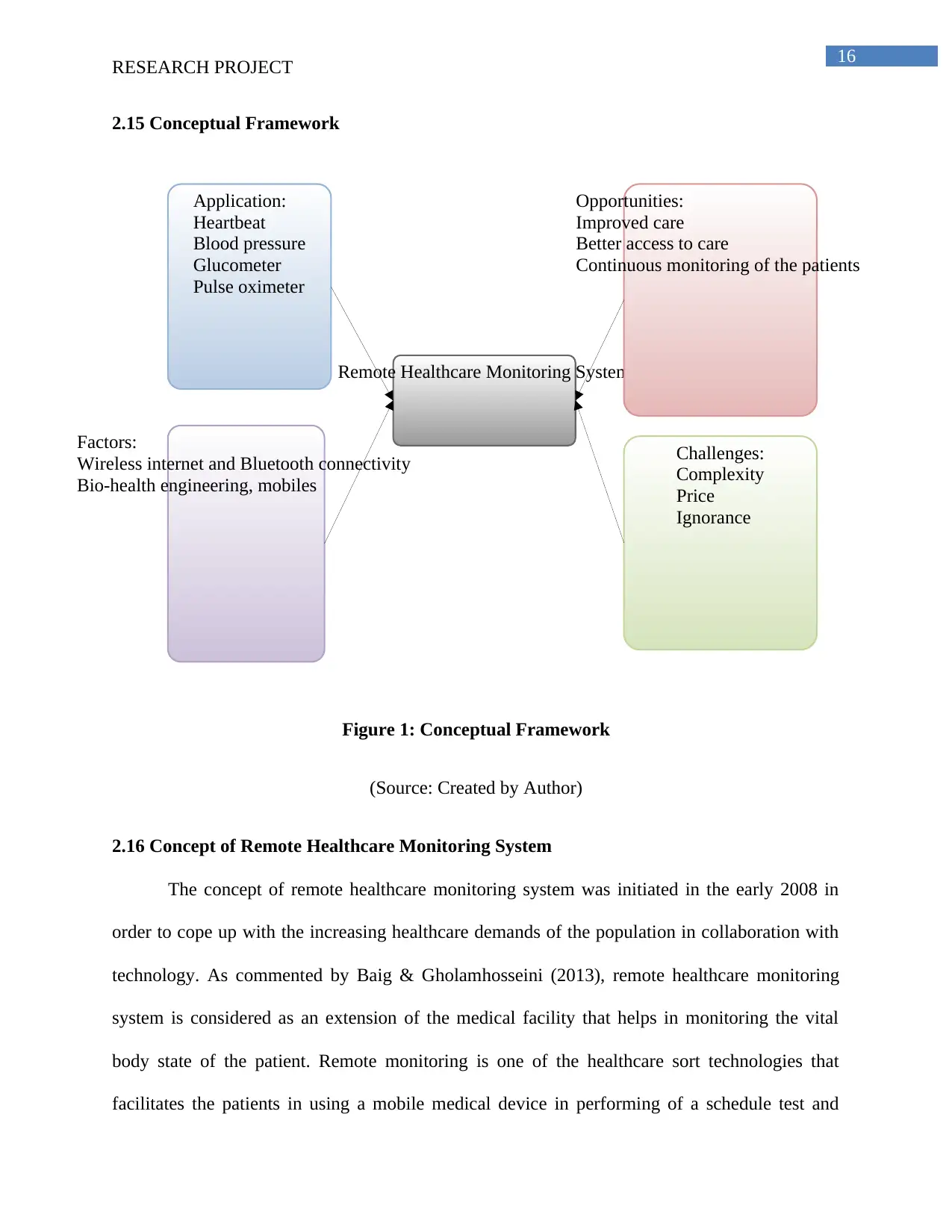
16
Remote Healthcare Monitoring System
Application:
Heartbeat
Blood pressure
Glucometer
Pulse oximeter
Challenges:
Complexity
Price
Ignorance
Opportunities:
Improved care
Better access to care
Continuous monitoring of the patients
Factors:
Wireless internet and Bluetooth connectivity
Bio-health engineering, mobiles
RESEARCH PROJECT
2.15 Conceptual Framework
Figure 1: Conceptual Framework
(Source: Created by Author)
2.16 Concept of Remote Healthcare Monitoring System
The concept of remote healthcare monitoring system was initiated in the early 2008 in
order to cope up with the increasing healthcare demands of the population in collaboration with
technology. As commented by Baig & Gholamhosseini (2013), remote healthcare monitoring
system is considered as an extension of the medical facility that helps in monitoring the vital
body state of the patient. Remote monitoring is one of the healthcare sort technologies that
facilitates the patients in using a mobile medical device in performing of a schedule test and
Remote Healthcare Monitoring System
Application:
Heartbeat
Blood pressure
Glucometer
Pulse oximeter
Challenges:
Complexity
Price
Ignorance
Opportunities:
Improved care
Better access to care
Continuous monitoring of the patients
Factors:
Wireless internet and Bluetooth connectivity
Bio-health engineering, mobiles
RESEARCH PROJECT
2.15 Conceptual Framework
Figure 1: Conceptual Framework
(Source: Created by Author)
2.16 Concept of Remote Healthcare Monitoring System
The concept of remote healthcare monitoring system was initiated in the early 2008 in
order to cope up with the increasing healthcare demands of the population in collaboration with
technology. As commented by Baig & Gholamhosseini (2013), remote healthcare monitoring
system is considered as an extension of the medical facility that helps in monitoring the vital
body state of the patient. Remote monitoring is one of the healthcare sort technologies that
facilitates the patients in using a mobile medical device in performing of a schedule test and
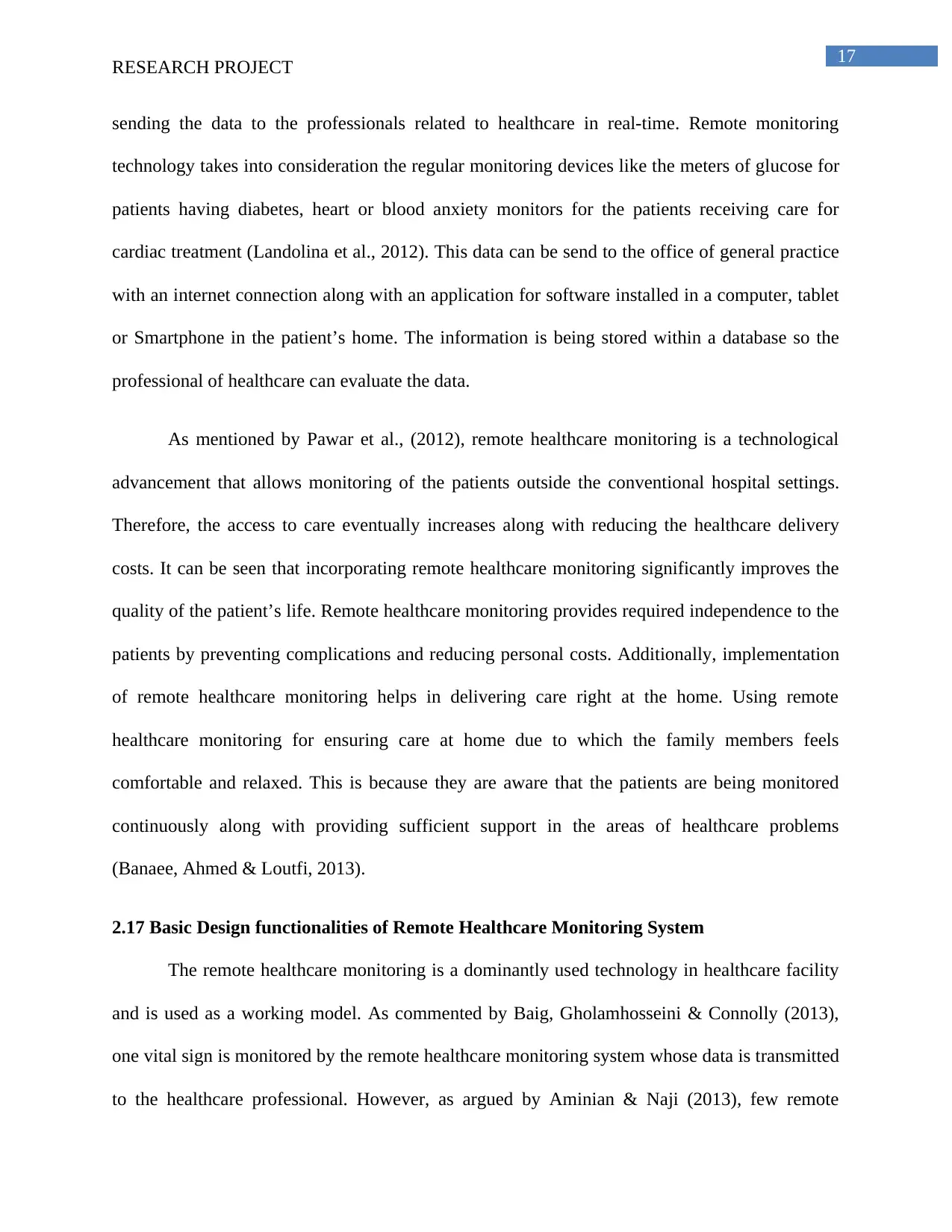
17
RESEARCH PROJECT
sending the data to the professionals related to healthcare in real-time. Remote monitoring
technology takes into consideration the regular monitoring devices like the meters of glucose for
patients having diabetes, heart or blood anxiety monitors for the patients receiving care for
cardiac treatment (Landolina et al., 2012). This data can be send to the office of general practice
with an internet connection along with an application for software installed in a computer, tablet
or Smartphone in the patient’s home. The information is being stored within a database so the
professional of healthcare can evaluate the data.
As mentioned by Pawar et al., (2012), remote healthcare monitoring is a technological
advancement that allows monitoring of the patients outside the conventional hospital settings.
Therefore, the access to care eventually increases along with reducing the healthcare delivery
costs. It can be seen that incorporating remote healthcare monitoring significantly improves the
quality of the patient’s life. Remote healthcare monitoring provides required independence to the
patients by preventing complications and reducing personal costs. Additionally, implementation
of remote healthcare monitoring helps in delivering care right at the home. Using remote
healthcare monitoring for ensuring care at home due to which the family members feels
comfortable and relaxed. This is because they are aware that the patients are being monitored
continuously along with providing sufficient support in the areas of healthcare problems
(Banaee, Ahmed & Loutfi, 2013).
2.17 Basic Design functionalities of Remote Healthcare Monitoring System
The remote healthcare monitoring is a dominantly used technology in healthcare facility
and is used as a working model. As commented by Baig, Gholamhosseini & Connolly (2013),
one vital sign is monitored by the remote healthcare monitoring system whose data is transmitted
to the healthcare professional. However, as argued by Aminian & Naji (2013), few remote
RESEARCH PROJECT
sending the data to the professionals related to healthcare in real-time. Remote monitoring
technology takes into consideration the regular monitoring devices like the meters of glucose for
patients having diabetes, heart or blood anxiety monitors for the patients receiving care for
cardiac treatment (Landolina et al., 2012). This data can be send to the office of general practice
with an internet connection along with an application for software installed in a computer, tablet
or Smartphone in the patient’s home. The information is being stored within a database so the
professional of healthcare can evaluate the data.
As mentioned by Pawar et al., (2012), remote healthcare monitoring is a technological
advancement that allows monitoring of the patients outside the conventional hospital settings.
Therefore, the access to care eventually increases along with reducing the healthcare delivery
costs. It can be seen that incorporating remote healthcare monitoring significantly improves the
quality of the patient’s life. Remote healthcare monitoring provides required independence to the
patients by preventing complications and reducing personal costs. Additionally, implementation
of remote healthcare monitoring helps in delivering care right at the home. Using remote
healthcare monitoring for ensuring care at home due to which the family members feels
comfortable and relaxed. This is because they are aware that the patients are being monitored
continuously along with providing sufficient support in the areas of healthcare problems
(Banaee, Ahmed & Loutfi, 2013).
2.17 Basic Design functionalities of Remote Healthcare Monitoring System
The remote healthcare monitoring is a dominantly used technology in healthcare facility
and is used as a working model. As commented by Baig, Gholamhosseini & Connolly (2013),
one vital sign is monitored by the remote healthcare monitoring system whose data is transmitted
to the healthcare professional. However, as argued by Aminian & Naji (2013), few remote

18
RESEARCH PROJECT
healthcare monitoring systems helps in monitoring all the vital signs of the patient as well as
conducting video recording. The data derived from the remote healthcare monitoring system are
sent to the clinical practitioners for diagnosis and treatment. The basic remote healthcare
monitoring systems include the set top box, blood pressure monitor, pulse oximeter, blood
glucose meter, ear temperature, body temperature, spirometer and accelerometer.
Figure 2: Remote healthcare monitoring systems
(Source: Banaee, Ahmed & Loutfi, 2013)
Set top box: Set top box is the most important part of the entire set up as this helps in running
the software application. The main function of the set top box includes deriving physiological
data of the patient from different medical devices and transmitting them in real time data in
presence of secured internet connection that is connected to either personal computer or laptop
(Istepanian, Laxminarayan & Pattichis, 2014).
RESEARCH PROJECT
healthcare monitoring systems helps in monitoring all the vital signs of the patient as well as
conducting video recording. The data derived from the remote healthcare monitoring system are
sent to the clinical practitioners for diagnosis and treatment. The basic remote healthcare
monitoring systems include the set top box, blood pressure monitor, pulse oximeter, blood
glucose meter, ear temperature, body temperature, spirometer and accelerometer.
Figure 2: Remote healthcare monitoring systems
(Source: Banaee, Ahmed & Loutfi, 2013)
Set top box: Set top box is the most important part of the entire set up as this helps in running
the software application. The main function of the set top box includes deriving physiological
data of the patient from different medical devices and transmitting them in real time data in
presence of secured internet connection that is connected to either personal computer or laptop
(Istepanian, Laxminarayan & Pattichis, 2014).
Paraphrase This Document
Need a fresh take? Get an instant paraphrase of this document with our AI Paraphraser
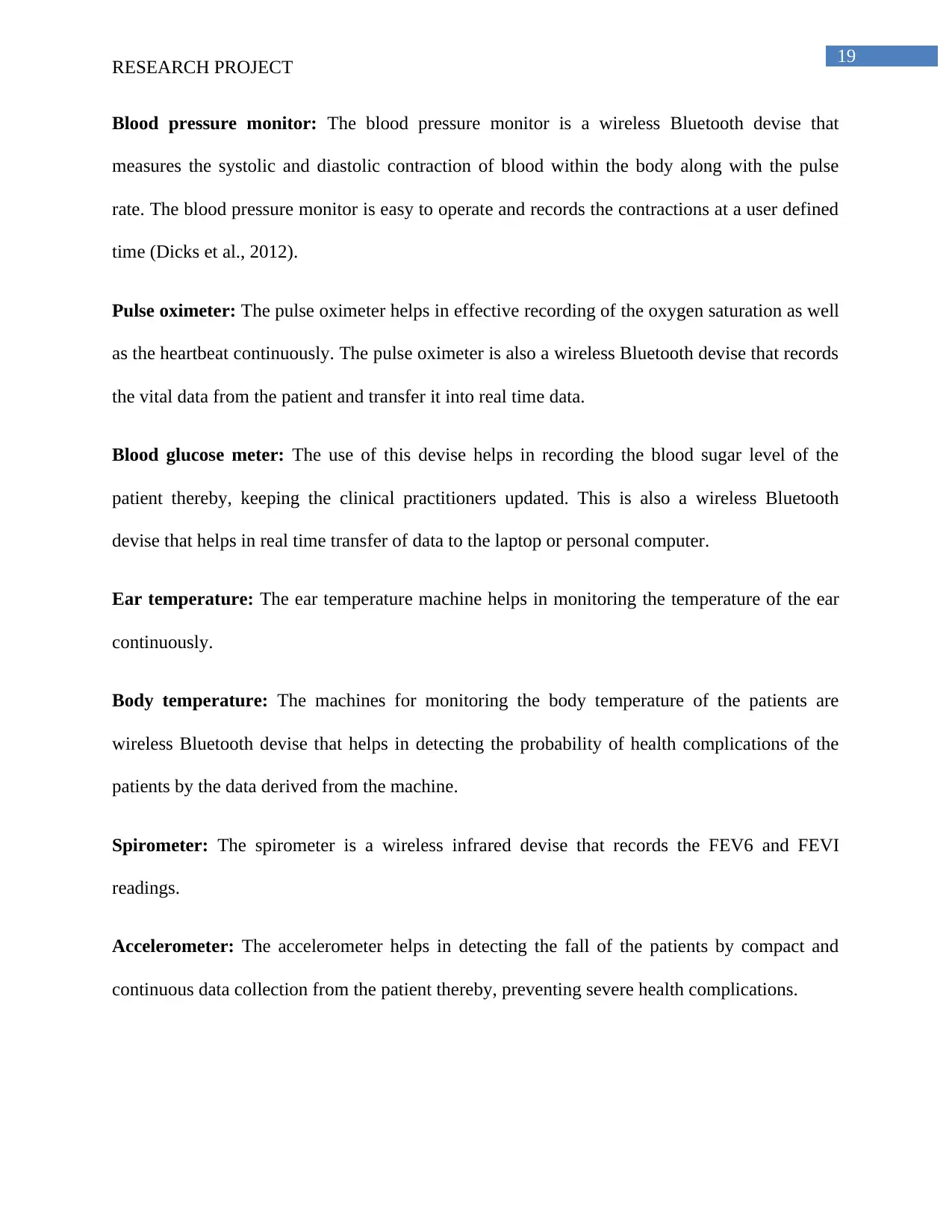
19
RESEARCH PROJECT
Blood pressure monitor: The blood pressure monitor is a wireless Bluetooth devise that
measures the systolic and diastolic contraction of blood within the body along with the pulse
rate. The blood pressure monitor is easy to operate and records the contractions at a user defined
time (Dicks et al., 2012).
Pulse oximeter: The pulse oximeter helps in effective recording of the oxygen saturation as well
as the heartbeat continuously. The pulse oximeter is also a wireless Bluetooth devise that records
the vital data from the patient and transfer it into real time data.
Blood glucose meter: The use of this devise helps in recording the blood sugar level of the
patient thereby, keeping the clinical practitioners updated. This is also a wireless Bluetooth
devise that helps in real time transfer of data to the laptop or personal computer.
Ear temperature: The ear temperature machine helps in monitoring the temperature of the ear
continuously.
Body temperature: The machines for monitoring the body temperature of the patients are
wireless Bluetooth devise that helps in detecting the probability of health complications of the
patients by the data derived from the machine.
Spirometer: The spirometer is a wireless infrared devise that records the FEV6 and FEVI
readings.
Accelerometer: The accelerometer helps in detecting the fall of the patients by compact and
continuous data collection from the patient thereby, preventing severe health complications.
RESEARCH PROJECT
Blood pressure monitor: The blood pressure monitor is a wireless Bluetooth devise that
measures the systolic and diastolic contraction of blood within the body along with the pulse
rate. The blood pressure monitor is easy to operate and records the contractions at a user defined
time (Dicks et al., 2012).
Pulse oximeter: The pulse oximeter helps in effective recording of the oxygen saturation as well
as the heartbeat continuously. The pulse oximeter is also a wireless Bluetooth devise that records
the vital data from the patient and transfer it into real time data.
Blood glucose meter: The use of this devise helps in recording the blood sugar level of the
patient thereby, keeping the clinical practitioners updated. This is also a wireless Bluetooth
devise that helps in real time transfer of data to the laptop or personal computer.
Ear temperature: The ear temperature machine helps in monitoring the temperature of the ear
continuously.
Body temperature: The machines for monitoring the body temperature of the patients are
wireless Bluetooth devise that helps in detecting the probability of health complications of the
patients by the data derived from the machine.
Spirometer: The spirometer is a wireless infrared devise that records the FEV6 and FEVI
readings.
Accelerometer: The accelerometer helps in detecting the fall of the patients by compact and
continuous data collection from the patient thereby, preventing severe health complications.
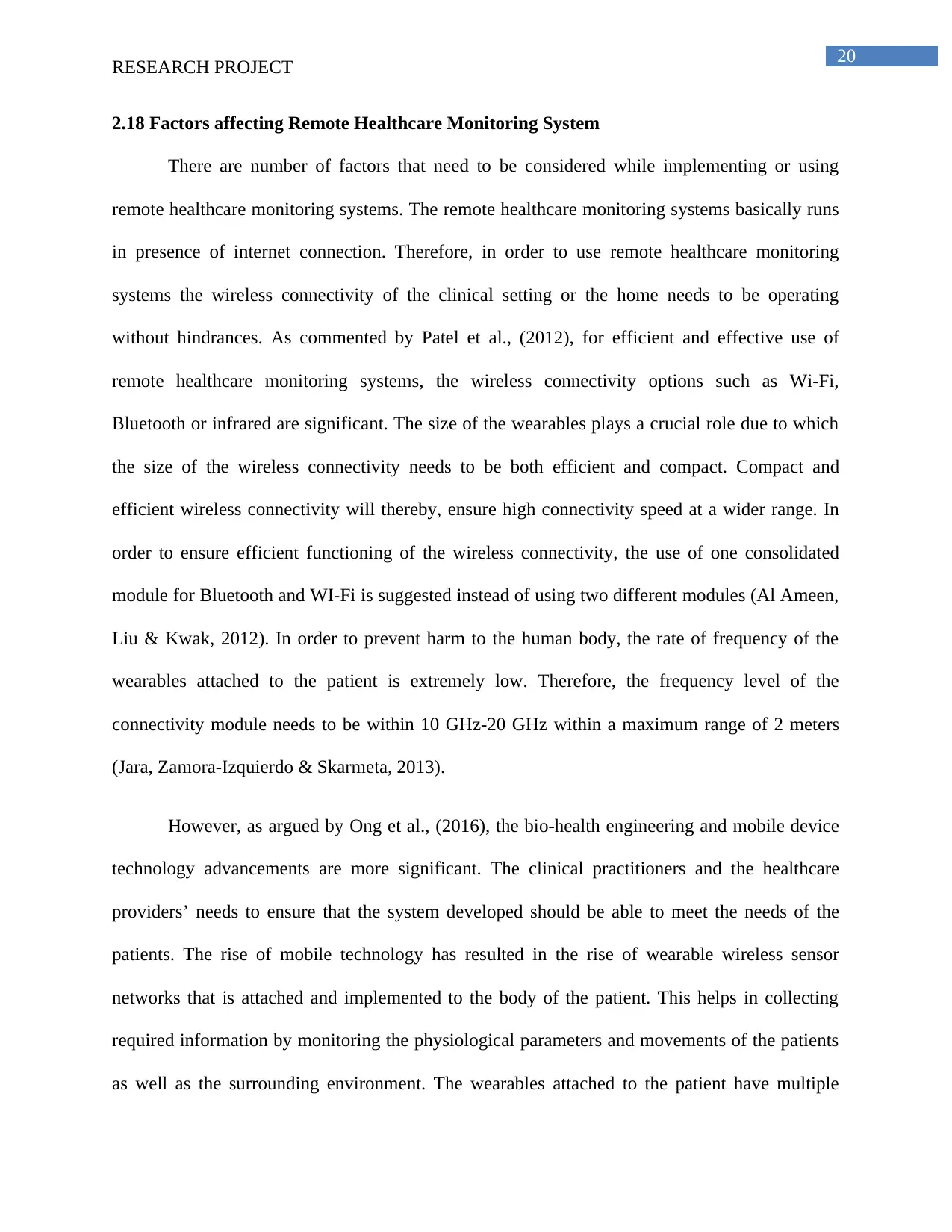
20
RESEARCH PROJECT
2.18 Factors affecting Remote Healthcare Monitoring System
There are number of factors that need to be considered while implementing or using
remote healthcare monitoring systems. The remote healthcare monitoring systems basically runs
in presence of internet connection. Therefore, in order to use remote healthcare monitoring
systems the wireless connectivity of the clinical setting or the home needs to be operating
without hindrances. As commented by Patel et al., (2012), for efficient and effective use of
remote healthcare monitoring systems, the wireless connectivity options such as Wi-Fi,
Bluetooth or infrared are significant. The size of the wearables plays a crucial role due to which
the size of the wireless connectivity needs to be both efficient and compact. Compact and
efficient wireless connectivity will thereby, ensure high connectivity speed at a wider range. In
order to ensure efficient functioning of the wireless connectivity, the use of one consolidated
module for Bluetooth and WI-Fi is suggested instead of using two different modules (Al Ameen,
Liu & Kwak, 2012). In order to prevent harm to the human body, the rate of frequency of the
wearables attached to the patient is extremely low. Therefore, the frequency level of the
connectivity module needs to be within 10 GHz-20 GHz within a maximum range of 2 meters
(Jara, Zamora-Izquierdo & Skarmeta, 2013).
However, as argued by Ong et al., (2016), the bio-health engineering and mobile device
technology advancements are more significant. The clinical practitioners and the healthcare
providers’ needs to ensure that the system developed should be able to meet the needs of the
patients. The rise of mobile technology has resulted in the rise of wearable wireless sensor
networks that is attached and implemented to the body of the patient. This helps in collecting
required information by monitoring the physiological parameters and movements of the patients
as well as the surrounding environment. The wearables attached to the patient have multiple
RESEARCH PROJECT
2.18 Factors affecting Remote Healthcare Monitoring System
There are number of factors that need to be considered while implementing or using
remote healthcare monitoring systems. The remote healthcare monitoring systems basically runs
in presence of internet connection. Therefore, in order to use remote healthcare monitoring
systems the wireless connectivity of the clinical setting or the home needs to be operating
without hindrances. As commented by Patel et al., (2012), for efficient and effective use of
remote healthcare monitoring systems, the wireless connectivity options such as Wi-Fi,
Bluetooth or infrared are significant. The size of the wearables plays a crucial role due to which
the size of the wireless connectivity needs to be both efficient and compact. Compact and
efficient wireless connectivity will thereby, ensure high connectivity speed at a wider range. In
order to ensure efficient functioning of the wireless connectivity, the use of one consolidated
module for Bluetooth and WI-Fi is suggested instead of using two different modules (Al Ameen,
Liu & Kwak, 2012). In order to prevent harm to the human body, the rate of frequency of the
wearables attached to the patient is extremely low. Therefore, the frequency level of the
connectivity module needs to be within 10 GHz-20 GHz within a maximum range of 2 meters
(Jara, Zamora-Izquierdo & Skarmeta, 2013).
However, as argued by Ong et al., (2016), the bio-health engineering and mobile device
technology advancements are more significant. The clinical practitioners and the healthcare
providers’ needs to ensure that the system developed should be able to meet the needs of the
patients. The rise of mobile technology has resulted in the rise of wearable wireless sensor
networks that is attached and implemented to the body of the patient. This helps in collecting
required information by monitoring the physiological parameters and movements of the patients
as well as the surrounding environment. The wearables attached to the patient have multiple
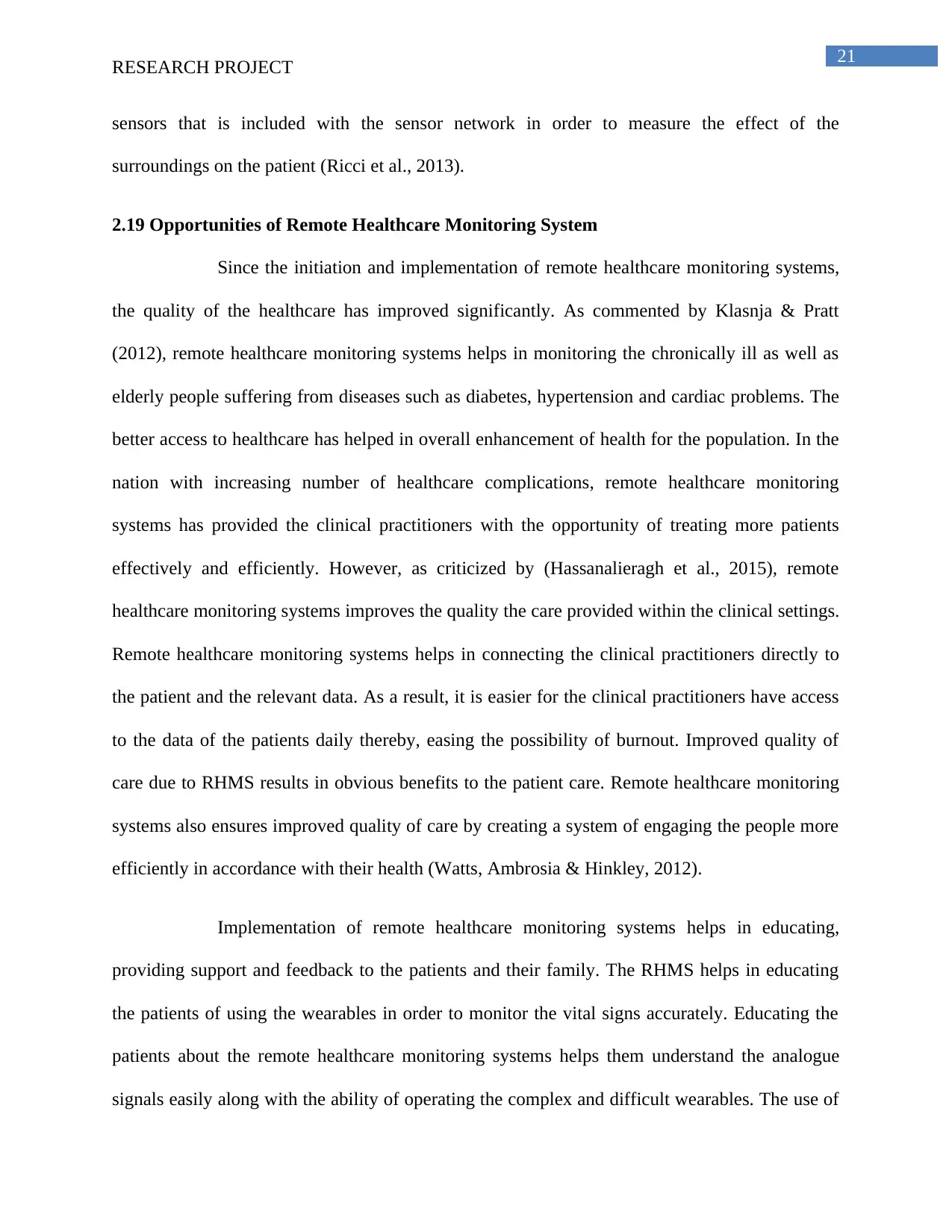
21
RESEARCH PROJECT
sensors that is included with the sensor network in order to measure the effect of the
surroundings on the patient (Ricci et al., 2013).
2.19 Opportunities of Remote Healthcare Monitoring System
Since the initiation and implementation of remote healthcare monitoring systems,
the quality of the healthcare has improved significantly. As commented by Klasnja & Pratt
(2012), remote healthcare monitoring systems helps in monitoring the chronically ill as well as
elderly people suffering from diseases such as diabetes, hypertension and cardiac problems. The
better access to healthcare has helped in overall enhancement of health for the population. In the
nation with increasing number of healthcare complications, remote healthcare monitoring
systems has provided the clinical practitioners with the opportunity of treating more patients
effectively and efficiently. However, as criticized by (Hassanalieragh et al., 2015), remote
healthcare monitoring systems improves the quality the care provided within the clinical settings.
Remote healthcare monitoring systems helps in connecting the clinical practitioners directly to
the patient and the relevant data. As a result, it is easier for the clinical practitioners have access
to the data of the patients daily thereby, easing the possibility of burnout. Improved quality of
care due to RHMS results in obvious benefits to the patient care. Remote healthcare monitoring
systems also ensures improved quality of care by creating a system of engaging the people more
efficiently in accordance with their health (Watts, Ambrosia & Hinkley, 2012).
Implementation of remote healthcare monitoring systems helps in educating,
providing support and feedback to the patients and their family. The RHMS helps in educating
the patients of using the wearables in order to monitor the vital signs accurately. Educating the
patients about the remote healthcare monitoring systems helps them understand the analogue
signals easily along with the ability of operating the complex and difficult wearables. The use of
RESEARCH PROJECT
sensors that is included with the sensor network in order to measure the effect of the
surroundings on the patient (Ricci et al., 2013).
2.19 Opportunities of Remote Healthcare Monitoring System
Since the initiation and implementation of remote healthcare monitoring systems,
the quality of the healthcare has improved significantly. As commented by Klasnja & Pratt
(2012), remote healthcare monitoring systems helps in monitoring the chronically ill as well as
elderly people suffering from diseases such as diabetes, hypertension and cardiac problems. The
better access to healthcare has helped in overall enhancement of health for the population. In the
nation with increasing number of healthcare complications, remote healthcare monitoring
systems has provided the clinical practitioners with the opportunity of treating more patients
effectively and efficiently. However, as criticized by (Hassanalieragh et al., 2015), remote
healthcare monitoring systems improves the quality the care provided within the clinical settings.
Remote healthcare monitoring systems helps in connecting the clinical practitioners directly to
the patient and the relevant data. As a result, it is easier for the clinical practitioners have access
to the data of the patients daily thereby, easing the possibility of burnout. Improved quality of
care due to RHMS results in obvious benefits to the patient care. Remote healthcare monitoring
systems also ensures improved quality of care by creating a system of engaging the people more
efficiently in accordance with their health (Watts, Ambrosia & Hinkley, 2012).
Implementation of remote healthcare monitoring systems helps in educating,
providing support and feedback to the patients and their family. The RHMS helps in educating
the patients of using the wearables in order to monitor the vital signs accurately. Educating the
patients about the remote healthcare monitoring systems helps them understand the analogue
signals easily along with the ability of operating the complex and difficult wearables. The use of
Secure Best Marks with AI Grader
Need help grading? Try our AI Grader for instant feedback on your assignments.
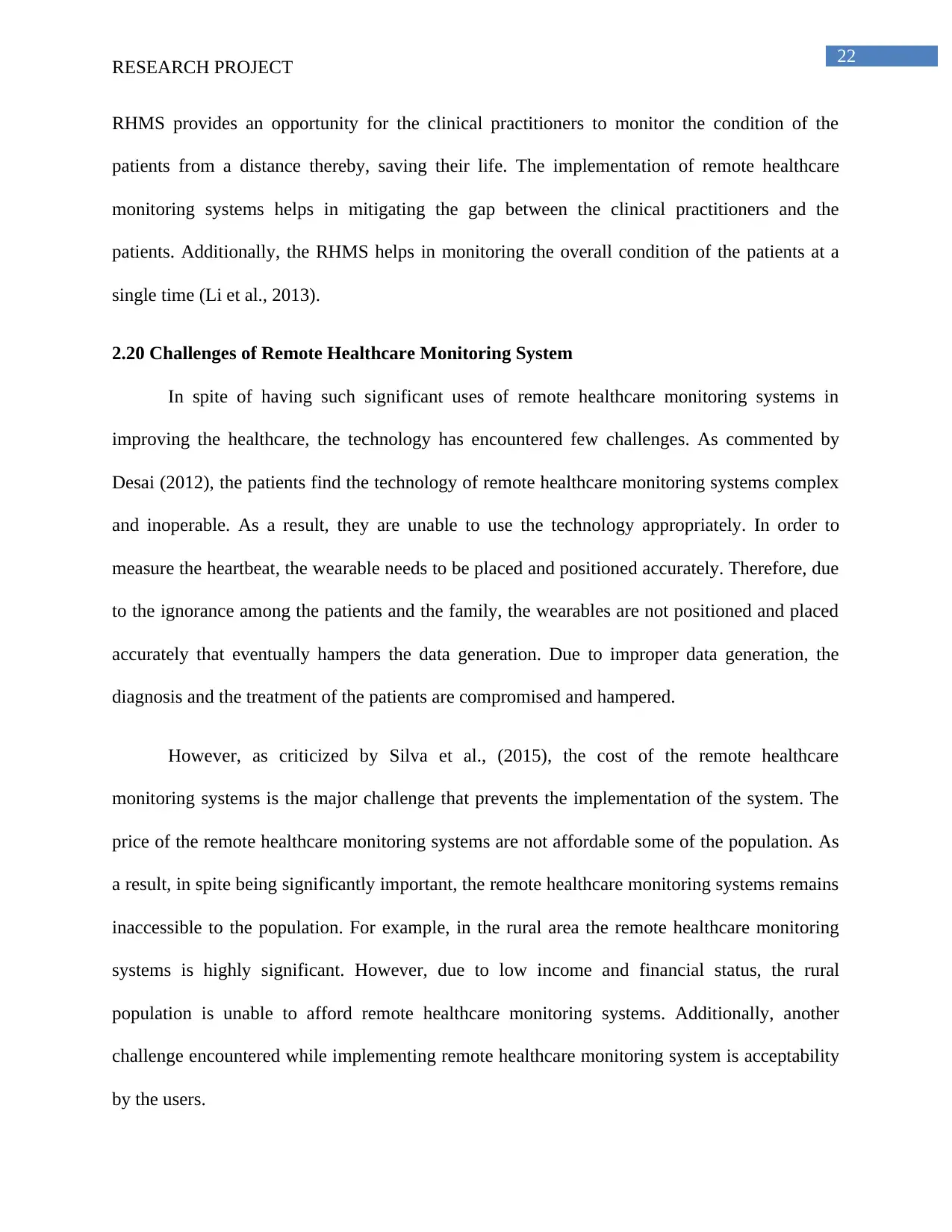
22
RESEARCH PROJECT
RHMS provides an opportunity for the clinical practitioners to monitor the condition of the
patients from a distance thereby, saving their life. The implementation of remote healthcare
monitoring systems helps in mitigating the gap between the clinical practitioners and the
patients. Additionally, the RHMS helps in monitoring the overall condition of the patients at a
single time (Li et al., 2013).
2.20 Challenges of Remote Healthcare Monitoring System
In spite of having such significant uses of remote healthcare monitoring systems in
improving the healthcare, the technology has encountered few challenges. As commented by
Desai (2012), the patients find the technology of remote healthcare monitoring systems complex
and inoperable. As a result, they are unable to use the technology appropriately. In order to
measure the heartbeat, the wearable needs to be placed and positioned accurately. Therefore, due
to the ignorance among the patients and the family, the wearables are not positioned and placed
accurately that eventually hampers the data generation. Due to improper data generation, the
diagnosis and the treatment of the patients are compromised and hampered.
However, as criticized by Silva et al., (2015), the cost of the remote healthcare
monitoring systems is the major challenge that prevents the implementation of the system. The
price of the remote healthcare monitoring systems are not affordable some of the population. As
a result, in spite being significantly important, the remote healthcare monitoring systems remains
inaccessible to the population. For example, in the rural area the remote healthcare monitoring
systems is highly significant. However, due to low income and financial status, the rural
population is unable to afford remote healthcare monitoring systems. Additionally, another
challenge encountered while implementing remote healthcare monitoring system is acceptability
by the users.
RESEARCH PROJECT
RHMS provides an opportunity for the clinical practitioners to monitor the condition of the
patients from a distance thereby, saving their life. The implementation of remote healthcare
monitoring systems helps in mitigating the gap between the clinical practitioners and the
patients. Additionally, the RHMS helps in monitoring the overall condition of the patients at a
single time (Li et al., 2013).
2.20 Challenges of Remote Healthcare Monitoring System
In spite of having such significant uses of remote healthcare monitoring systems in
improving the healthcare, the technology has encountered few challenges. As commented by
Desai (2012), the patients find the technology of remote healthcare monitoring systems complex
and inoperable. As a result, they are unable to use the technology appropriately. In order to
measure the heartbeat, the wearable needs to be placed and positioned accurately. Therefore, due
to the ignorance among the patients and the family, the wearables are not positioned and placed
accurately that eventually hampers the data generation. Due to improper data generation, the
diagnosis and the treatment of the patients are compromised and hampered.
However, as criticized by Silva et al., (2015), the cost of the remote healthcare
monitoring systems is the major challenge that prevents the implementation of the system. The
price of the remote healthcare monitoring systems are not affordable some of the population. As
a result, in spite being significantly important, the remote healthcare monitoring systems remains
inaccessible to the population. For example, in the rural area the remote healthcare monitoring
systems is highly significant. However, due to low income and financial status, the rural
population is unable to afford remote healthcare monitoring systems. Additionally, another
challenge encountered while implementing remote healthcare monitoring system is acceptability
by the users.
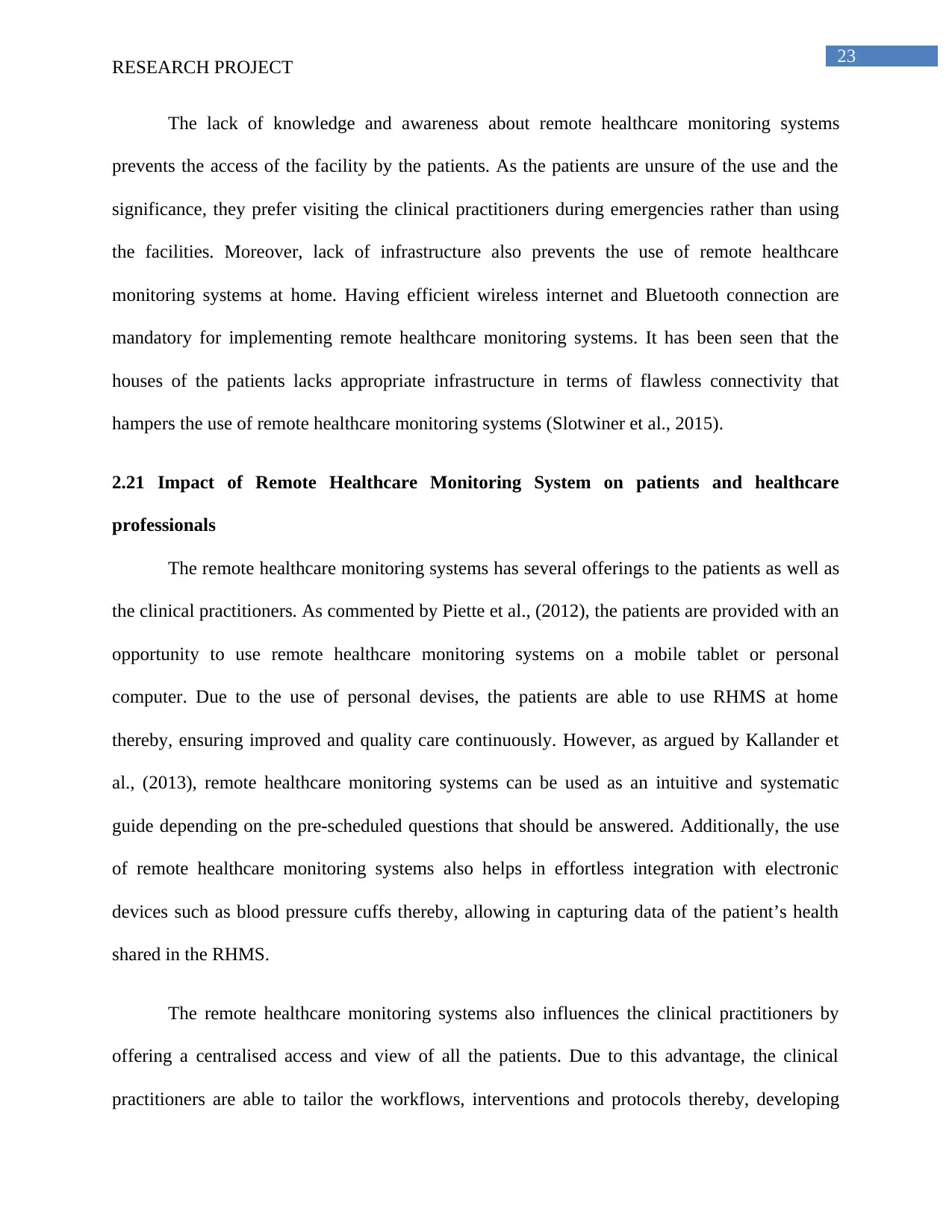
23
RESEARCH PROJECT
The lack of knowledge and awareness about remote healthcare monitoring systems
prevents the access of the facility by the patients. As the patients are unsure of the use and the
significance, they prefer visiting the clinical practitioners during emergencies rather than using
the facilities. Moreover, lack of infrastructure also prevents the use of remote healthcare
monitoring systems at home. Having efficient wireless internet and Bluetooth connection are
mandatory for implementing remote healthcare monitoring systems. It has been seen that the
houses of the patients lacks appropriate infrastructure in terms of flawless connectivity that
hampers the use of remote healthcare monitoring systems (Slotwiner et al., 2015).
2.21 Impact of Remote Healthcare Monitoring System on patients and healthcare
professionals
The remote healthcare monitoring systems has several offerings to the patients as well as
the clinical practitioners. As commented by Piette et al., (2012), the patients are provided with an
opportunity to use remote healthcare monitoring systems on a mobile tablet or personal
computer. Due to the use of personal devises, the patients are able to use RHMS at home
thereby, ensuring improved and quality care continuously. However, as argued by Kallander et
al., (2013), remote healthcare monitoring systems can be used as an intuitive and systematic
guide depending on the pre-scheduled questions that should be answered. Additionally, the use
of remote healthcare monitoring systems also helps in effortless integration with electronic
devices such as blood pressure cuffs thereby, allowing in capturing data of the patient’s health
shared in the RHMS.
The remote healthcare monitoring systems also influences the clinical practitioners by
offering a centralised access and view of all the patients. Due to this advantage, the clinical
practitioners are able to tailor the workflows, interventions and protocols thereby, developing
RESEARCH PROJECT
The lack of knowledge and awareness about remote healthcare monitoring systems
prevents the access of the facility by the patients. As the patients are unsure of the use and the
significance, they prefer visiting the clinical practitioners during emergencies rather than using
the facilities. Moreover, lack of infrastructure also prevents the use of remote healthcare
monitoring systems at home. Having efficient wireless internet and Bluetooth connection are
mandatory for implementing remote healthcare monitoring systems. It has been seen that the
houses of the patients lacks appropriate infrastructure in terms of flawless connectivity that
hampers the use of remote healthcare monitoring systems (Slotwiner et al., 2015).
2.21 Impact of Remote Healthcare Monitoring System on patients and healthcare
professionals
The remote healthcare monitoring systems has several offerings to the patients as well as
the clinical practitioners. As commented by Piette et al., (2012), the patients are provided with an
opportunity to use remote healthcare monitoring systems on a mobile tablet or personal
computer. Due to the use of personal devises, the patients are able to use RHMS at home
thereby, ensuring improved and quality care continuously. However, as argued by Kallander et
al., (2013), remote healthcare monitoring systems can be used as an intuitive and systematic
guide depending on the pre-scheduled questions that should be answered. Additionally, the use
of remote healthcare monitoring systems also helps in effortless integration with electronic
devices such as blood pressure cuffs thereby, allowing in capturing data of the patient’s health
shared in the RHMS.
The remote healthcare monitoring systems also influences the clinical practitioners by
offering a centralised access and view of all the patients. Due to this advantage, the clinical
practitioners are able to tailor the workflows, interventions and protocols thereby, developing
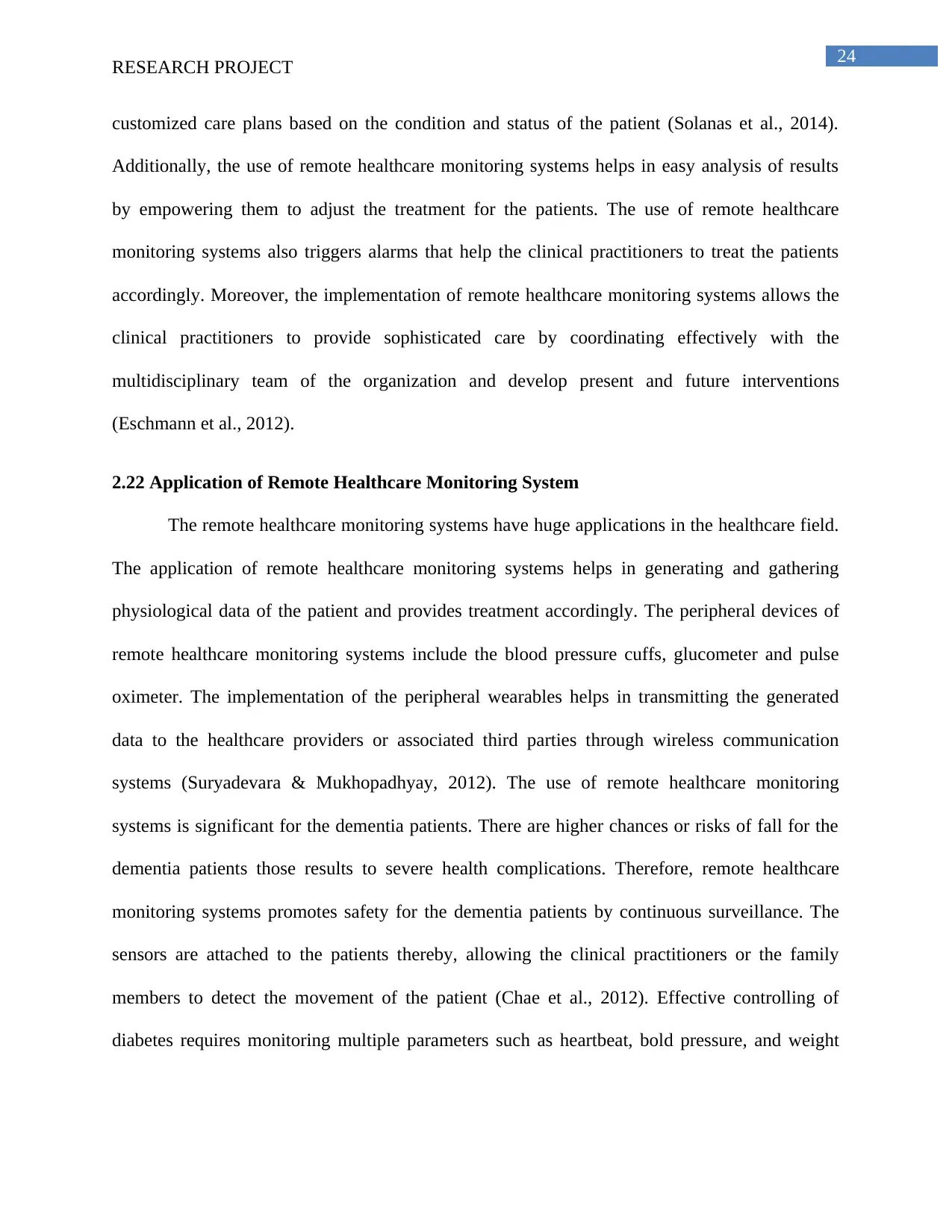
24
RESEARCH PROJECT
customized care plans based on the condition and status of the patient (Solanas et al., 2014).
Additionally, the use of remote healthcare monitoring systems helps in easy analysis of results
by empowering them to adjust the treatment for the patients. The use of remote healthcare
monitoring systems also triggers alarms that help the clinical practitioners to treat the patients
accordingly. Moreover, the implementation of remote healthcare monitoring systems allows the
clinical practitioners to provide sophisticated care by coordinating effectively with the
multidisciplinary team of the organization and develop present and future interventions
(Eschmann et al., 2012).
2.22 Application of Remote Healthcare Monitoring System
The remote healthcare monitoring systems have huge applications in the healthcare field.
The application of remote healthcare monitoring systems helps in generating and gathering
physiological data of the patient and provides treatment accordingly. The peripheral devices of
remote healthcare monitoring systems include the blood pressure cuffs, glucometer and pulse
oximeter. The implementation of the peripheral wearables helps in transmitting the generated
data to the healthcare providers or associated third parties through wireless communication
systems (Suryadevara & Mukhopadhyay, 2012). The use of remote healthcare monitoring
systems is significant for the dementia patients. There are higher chances or risks of fall for the
dementia patients those results to severe health complications. Therefore, remote healthcare
monitoring systems promotes safety for the dementia patients by continuous surveillance. The
sensors are attached to the patients thereby, allowing the clinical practitioners or the family
members to detect the movement of the patient (Chae et al., 2012). Effective controlling of
diabetes requires monitoring multiple parameters such as heartbeat, bold pressure, and weight
RESEARCH PROJECT
customized care plans based on the condition and status of the patient (Solanas et al., 2014).
Additionally, the use of remote healthcare monitoring systems helps in easy analysis of results
by empowering them to adjust the treatment for the patients. The use of remote healthcare
monitoring systems also triggers alarms that help the clinical practitioners to treat the patients
accordingly. Moreover, the implementation of remote healthcare monitoring systems allows the
clinical practitioners to provide sophisticated care by coordinating effectively with the
multidisciplinary team of the organization and develop present and future interventions
(Eschmann et al., 2012).
2.22 Application of Remote Healthcare Monitoring System
The remote healthcare monitoring systems have huge applications in the healthcare field.
The application of remote healthcare monitoring systems helps in generating and gathering
physiological data of the patient and provides treatment accordingly. The peripheral devices of
remote healthcare monitoring systems include the blood pressure cuffs, glucometer and pulse
oximeter. The implementation of the peripheral wearables helps in transmitting the generated
data to the healthcare providers or associated third parties through wireless communication
systems (Suryadevara & Mukhopadhyay, 2012). The use of remote healthcare monitoring
systems is significant for the dementia patients. There are higher chances or risks of fall for the
dementia patients those results to severe health complications. Therefore, remote healthcare
monitoring systems promotes safety for the dementia patients by continuous surveillance. The
sensors are attached to the patients thereby, allowing the clinical practitioners or the family
members to detect the movement of the patient (Chae et al., 2012). Effective controlling of
diabetes requires monitoring multiple parameters such as heartbeat, bold pressure, and weight
Paraphrase This Document
Need a fresh take? Get an instant paraphrase of this document with our AI Paraphraser
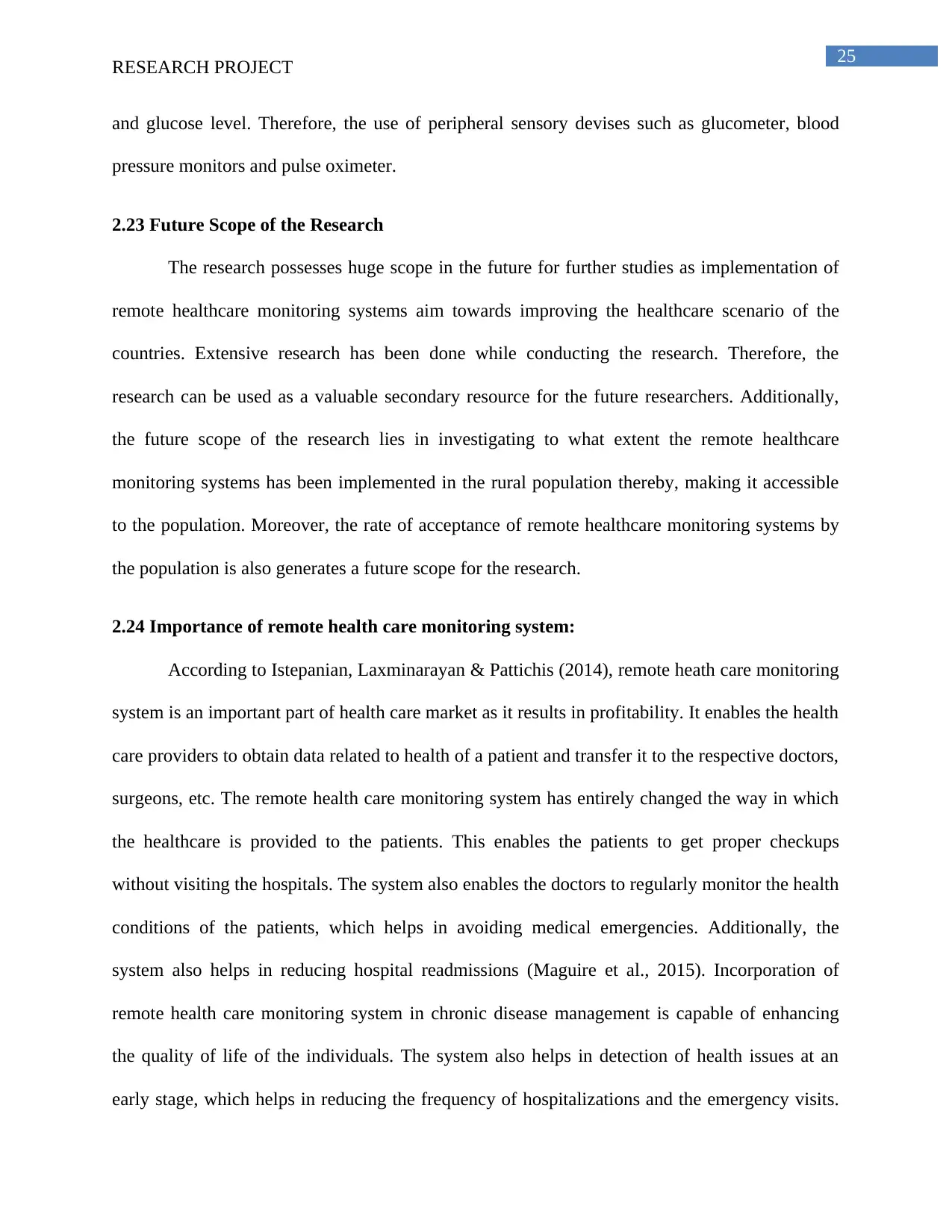
25
RESEARCH PROJECT
and glucose level. Therefore, the use of peripheral sensory devises such as glucometer, blood
pressure monitors and pulse oximeter.
2.23 Future Scope of the Research
The research possesses huge scope in the future for further studies as implementation of
remote healthcare monitoring systems aim towards improving the healthcare scenario of the
countries. Extensive research has been done while conducting the research. Therefore, the
research can be used as a valuable secondary resource for the future researchers. Additionally,
the future scope of the research lies in investigating to what extent the remote healthcare
monitoring systems has been implemented in the rural population thereby, making it accessible
to the population. Moreover, the rate of acceptance of remote healthcare monitoring systems by
the population is also generates a future scope for the research.
2.24 Importance of remote health care monitoring system:
According to Istepanian, Laxminarayan & Pattichis (2014), remote heath care monitoring
system is an important part of health care market as it results in profitability. It enables the health
care providers to obtain data related to health of a patient and transfer it to the respective doctors,
surgeons, etc. The remote health care monitoring system has entirely changed the way in which
the healthcare is provided to the patients. This enables the patients to get proper checkups
without visiting the hospitals. The system also enables the doctors to regularly monitor the health
conditions of the patients, which helps in avoiding medical emergencies. Additionally, the
system also helps in reducing hospital readmissions (Maguire et al., 2015). Incorporation of
remote health care monitoring system in chronic disease management is capable of enhancing
the quality of life of the individuals. The system also helps in detection of health issues at an
early stage, which helps in reducing the frequency of hospitalizations and the emergency visits.
RESEARCH PROJECT
and glucose level. Therefore, the use of peripheral sensory devises such as glucometer, blood
pressure monitors and pulse oximeter.
2.23 Future Scope of the Research
The research possesses huge scope in the future for further studies as implementation of
remote healthcare monitoring systems aim towards improving the healthcare scenario of the
countries. Extensive research has been done while conducting the research. Therefore, the
research can be used as a valuable secondary resource for the future researchers. Additionally,
the future scope of the research lies in investigating to what extent the remote healthcare
monitoring systems has been implemented in the rural population thereby, making it accessible
to the population. Moreover, the rate of acceptance of remote healthcare monitoring systems by
the population is also generates a future scope for the research.
2.24 Importance of remote health care monitoring system:
According to Istepanian, Laxminarayan & Pattichis (2014), remote heath care monitoring
system is an important part of health care market as it results in profitability. It enables the health
care providers to obtain data related to health of a patient and transfer it to the respective doctors,
surgeons, etc. The remote health care monitoring system has entirely changed the way in which
the healthcare is provided to the patients. This enables the patients to get proper checkups
without visiting the hospitals. The system also enables the doctors to regularly monitor the health
conditions of the patients, which helps in avoiding medical emergencies. Additionally, the
system also helps in reducing hospital readmissions (Maguire et al., 2015). Incorporation of
remote health care monitoring system in chronic disease management is capable of enhancing
the quality of life of the individuals. The system also helps in detection of health issues at an
early stage, which helps in reducing the frequency of hospitalizations and the emergency visits.
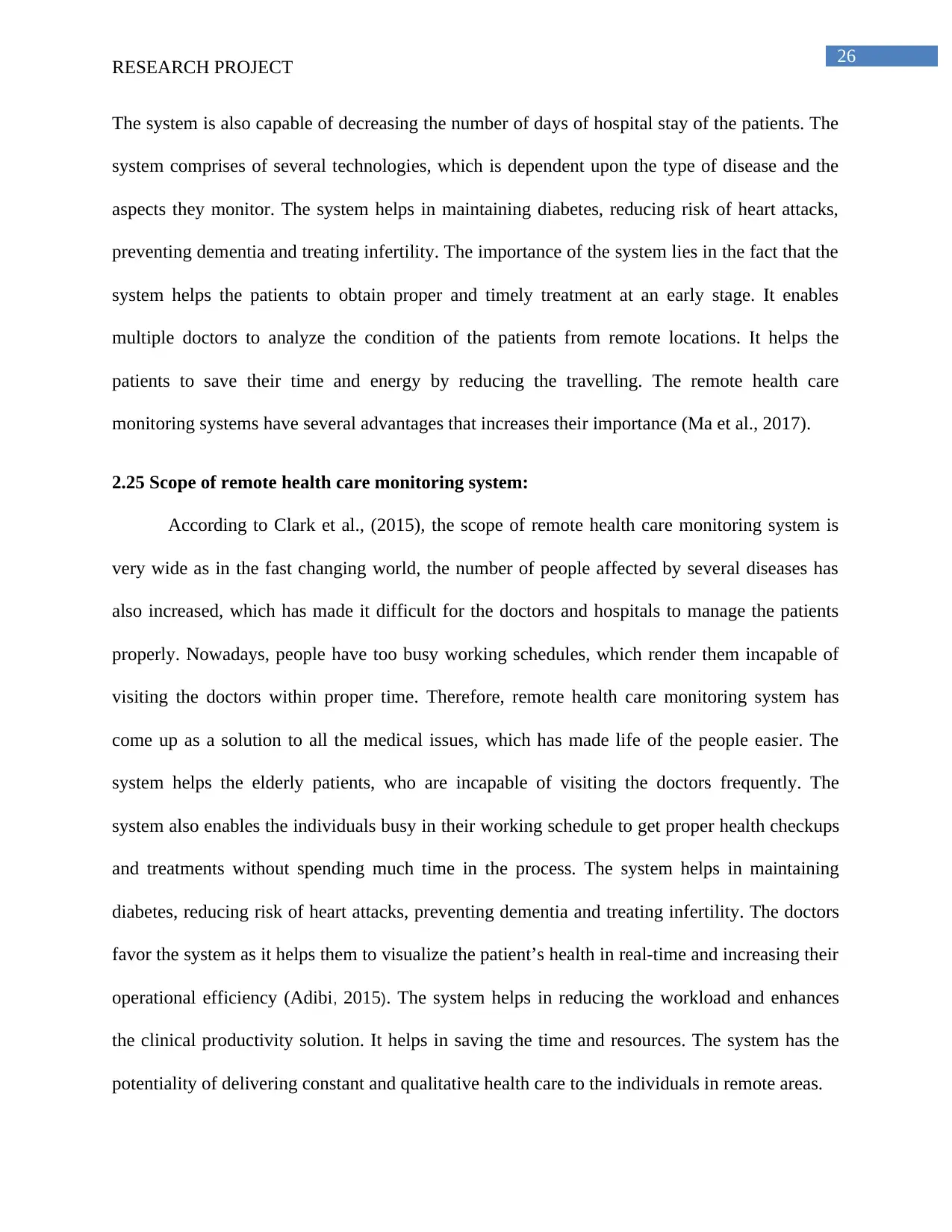
26
RESEARCH PROJECT
The system is also capable of decreasing the number of days of hospital stay of the patients. The
system comprises of several technologies, which is dependent upon the type of disease and the
aspects they monitor. The system helps in maintaining diabetes, reducing risk of heart attacks,
preventing dementia and treating infertility. The importance of the system lies in the fact that the
system helps the patients to obtain proper and timely treatment at an early stage. It enables
multiple doctors to analyze the condition of the patients from remote locations. It helps the
patients to save their time and energy by reducing the travelling. The remote health care
monitoring systems have several advantages that increases their importance (Ma et al., 2017).
2.25 Scope of remote health care monitoring system:
According to Clark et al., (2015), the scope of remote health care monitoring system is
very wide as in the fast changing world, the number of people affected by several diseases has
also increased, which has made it difficult for the doctors and hospitals to manage the patients
properly. Nowadays, people have too busy working schedules, which render them incapable of
visiting the doctors within proper time. Therefore, remote health care monitoring system has
come up as a solution to all the medical issues, which has made life of the people easier. The
system helps the elderly patients, who are incapable of visiting the doctors frequently. The
system also enables the individuals busy in their working schedule to get proper health checkups
and treatments without spending much time in the process. The system helps in maintaining
diabetes, reducing risk of heart attacks, preventing dementia and treating infertility. The doctors
favor the system as it helps them to visualize the patient’s health in real-time and increasing their
operational efficiency (Adibi, 2015). The system helps in reducing the workload and enhances
the clinical productivity solution. It helps in saving the time and resources. The system has the
potentiality of delivering constant and qualitative health care to the individuals in remote areas.
RESEARCH PROJECT
The system is also capable of decreasing the number of days of hospital stay of the patients. The
system comprises of several technologies, which is dependent upon the type of disease and the
aspects they monitor. The system helps in maintaining diabetes, reducing risk of heart attacks,
preventing dementia and treating infertility. The importance of the system lies in the fact that the
system helps the patients to obtain proper and timely treatment at an early stage. It enables
multiple doctors to analyze the condition of the patients from remote locations. It helps the
patients to save their time and energy by reducing the travelling. The remote health care
monitoring systems have several advantages that increases their importance (Ma et al., 2017).
2.25 Scope of remote health care monitoring system:
According to Clark et al., (2015), the scope of remote health care monitoring system is
very wide as in the fast changing world, the number of people affected by several diseases has
also increased, which has made it difficult for the doctors and hospitals to manage the patients
properly. Nowadays, people have too busy working schedules, which render them incapable of
visiting the doctors within proper time. Therefore, remote health care monitoring system has
come up as a solution to all the medical issues, which has made life of the people easier. The
system helps the elderly patients, who are incapable of visiting the doctors frequently. The
system also enables the individuals busy in their working schedule to get proper health checkups
and treatments without spending much time in the process. The system helps in maintaining
diabetes, reducing risk of heart attacks, preventing dementia and treating infertility. The doctors
favor the system as it helps them to visualize the patient’s health in real-time and increasing their
operational efficiency (Adibi, 2015). The system helps in reducing the workload and enhances
the clinical productivity solution. It helps in saving the time and resources. The system has the
potentiality of delivering constant and qualitative health care to the individuals in remote areas.
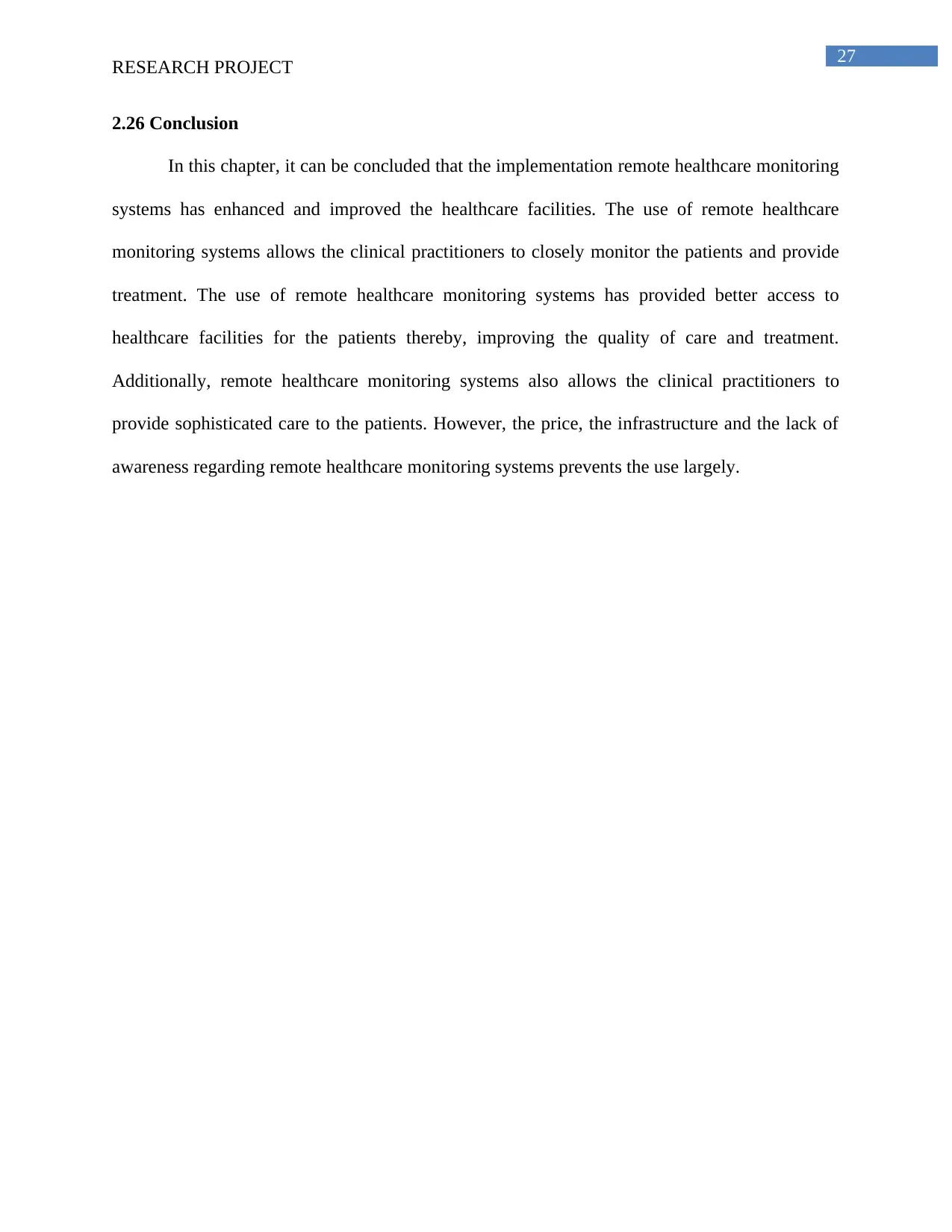
27
RESEARCH PROJECT
2.26 Conclusion
In this chapter, it can be concluded that the implementation remote healthcare monitoring
systems has enhanced and improved the healthcare facilities. The use of remote healthcare
monitoring systems allows the clinical practitioners to closely monitor the patients and provide
treatment. The use of remote healthcare monitoring systems has provided better access to
healthcare facilities for the patients thereby, improving the quality of care and treatment.
Additionally, remote healthcare monitoring systems also allows the clinical practitioners to
provide sophisticated care to the patients. However, the price, the infrastructure and the lack of
awareness regarding remote healthcare monitoring systems prevents the use largely.
RESEARCH PROJECT
2.26 Conclusion
In this chapter, it can be concluded that the implementation remote healthcare monitoring
systems has enhanced and improved the healthcare facilities. The use of remote healthcare
monitoring systems allows the clinical practitioners to closely monitor the patients and provide
treatment. The use of remote healthcare monitoring systems has provided better access to
healthcare facilities for the patients thereby, improving the quality of care and treatment.
Additionally, remote healthcare monitoring systems also allows the clinical practitioners to
provide sophisticated care to the patients. However, the price, the infrastructure and the lack of
awareness regarding remote healthcare monitoring systems prevents the use largely.
Secure Best Marks with AI Grader
Need help grading? Try our AI Grader for instant feedback on your assignments.
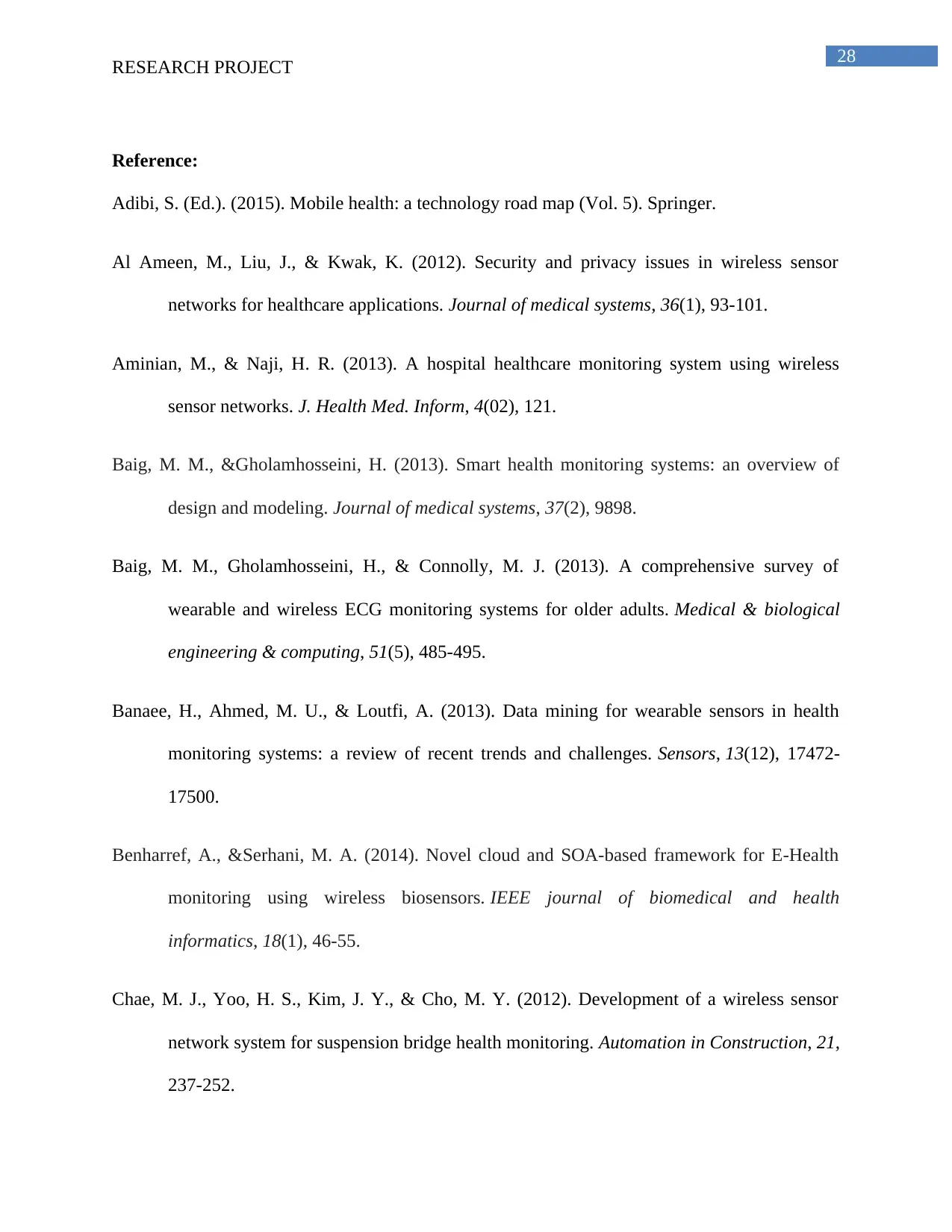
28
RESEARCH PROJECT
Reference:
Adibi, S. (Ed.). (2015). Mobile health: a technology road map (Vol. 5). Springer.
Al Ameen, M., Liu, J., & Kwak, K. (2012). Security and privacy issues in wireless sensor
networks for healthcare applications. Journal of medical systems, 36(1), 93-101.
Aminian, M., & Naji, H. R. (2013). A hospital healthcare monitoring system using wireless
sensor networks. J. Health Med. Inform, 4(02), 121.
Baig, M. M., &Gholamhosseini, H. (2013). Smart health monitoring systems: an overview of
design and modeling. Journal of medical systems, 37(2), 9898.
Baig, M. M., Gholamhosseini, H., & Connolly, M. J. (2013). A comprehensive survey of
wearable and wireless ECG monitoring systems for older adults. Medical & biological
engineering & computing, 51(5), 485-495.
Banaee, H., Ahmed, M. U., & Loutfi, A. (2013). Data mining for wearable sensors in health
monitoring systems: a review of recent trends and challenges. Sensors, 13(12), 17472-
17500.
Benharref, A., &Serhani, M. A. (2014). Novel cloud and SOA-based framework for E-Health
monitoring using wireless biosensors. IEEE journal of biomedical and health
informatics, 18(1), 46-55.
Chae, M. J., Yoo, H. S., Kim, J. Y., & Cho, M. Y. (2012). Development of a wireless sensor
network system for suspension bridge health monitoring. Automation in Construction, 21,
237-252.
RESEARCH PROJECT
Reference:
Adibi, S. (Ed.). (2015). Mobile health: a technology road map (Vol. 5). Springer.
Al Ameen, M., Liu, J., & Kwak, K. (2012). Security and privacy issues in wireless sensor
networks for healthcare applications. Journal of medical systems, 36(1), 93-101.
Aminian, M., & Naji, H. R. (2013). A hospital healthcare monitoring system using wireless
sensor networks. J. Health Med. Inform, 4(02), 121.
Baig, M. M., &Gholamhosseini, H. (2013). Smart health monitoring systems: an overview of
design and modeling. Journal of medical systems, 37(2), 9898.
Baig, M. M., Gholamhosseini, H., & Connolly, M. J. (2013). A comprehensive survey of
wearable and wireless ECG monitoring systems for older adults. Medical & biological
engineering & computing, 51(5), 485-495.
Banaee, H., Ahmed, M. U., & Loutfi, A. (2013). Data mining for wearable sensors in health
monitoring systems: a review of recent trends and challenges. Sensors, 13(12), 17472-
17500.
Benharref, A., &Serhani, M. A. (2014). Novel cloud and SOA-based framework for E-Health
monitoring using wireless biosensors. IEEE journal of biomedical and health
informatics, 18(1), 46-55.
Chae, M. J., Yoo, H. S., Kim, J. Y., & Cho, M. Y. (2012). Development of a wireless sensor
network system for suspension bridge health monitoring. Automation in Construction, 21,
237-252.

29
RESEARCH PROJECT
Chen, S., Xu, H., Liu, D., Hu, B., & Wang, H. (2014). A vision of IoT: Applications, challenges,
and opportunities with china perspective. IEEE Internet of Things journal, 1(4), 349-359.
Clark, M., Lim, J., Tewolde, G., & Kwon, J. (2015). Affordable remote health monitoring system
for the elderly using smart mobile device. Sensors & Transducers, 184(1), 77.
Desai, A. S. (2012). Home Monitoring Heart Failure Care Does Not Improve Patient
OutcomesResponse to Desai: Looking Beyond Telephone-Based Disease
Management. Circulation, 125(6), 828-836.
Dicks, K., Kent, R., Crosley, T., & Bartlett, T. (2012). U.S. Patent No. 8,126,735. Washington,
DC: U.S. Patent and Trademark Office.
Dinh, H. T., Lee, C., Niyato, D., & Wang, P. (2013). A survey of mobile cloud computing:
architecture, applications, and approaches. Wireless communications and mobile
computing, 13(18), 1587-1611.
Eschmann, C., Kuo, C. M., Kuo, C. H., & Boller, C. (2012, July). Unmanned aircraft systems for
remote building inspection and monitoring. In Proceedings of the 6th European
Workshop on Structural Health Monitoring, Dresden, Germany (Vol. 36).
Hassanalieragh, M., Page, A., Soyata, T., Sharma, G., Aktas, M., Mateos, G., ... &Andreescu, S.
(2015, June). Health monitoring and management using Internet-of-Things (IoT) sensing
with cloud-based processing: Opportunities and challenges. In Services Computing
(SCC), 2015 IEEE International Conference on (pp. 285-292). IEEE.
Hassanalieragh, M., Page, A., Soyata, T., Sharma, G., Aktas, M., Mateos, G., ... & Andreescu, S.
(2015, June). Health monitoring and management using Internet-of-Things (IoT) sensing
RESEARCH PROJECT
Chen, S., Xu, H., Liu, D., Hu, B., & Wang, H. (2014). A vision of IoT: Applications, challenges,
and opportunities with china perspective. IEEE Internet of Things journal, 1(4), 349-359.
Clark, M., Lim, J., Tewolde, G., & Kwon, J. (2015). Affordable remote health monitoring system
for the elderly using smart mobile device. Sensors & Transducers, 184(1), 77.
Desai, A. S. (2012). Home Monitoring Heart Failure Care Does Not Improve Patient
OutcomesResponse to Desai: Looking Beyond Telephone-Based Disease
Management. Circulation, 125(6), 828-836.
Dicks, K., Kent, R., Crosley, T., & Bartlett, T. (2012). U.S. Patent No. 8,126,735. Washington,
DC: U.S. Patent and Trademark Office.
Dinh, H. T., Lee, C., Niyato, D., & Wang, P. (2013). A survey of mobile cloud computing:
architecture, applications, and approaches. Wireless communications and mobile
computing, 13(18), 1587-1611.
Eschmann, C., Kuo, C. M., Kuo, C. H., & Boller, C. (2012, July). Unmanned aircraft systems for
remote building inspection and monitoring. In Proceedings of the 6th European
Workshop on Structural Health Monitoring, Dresden, Germany (Vol. 36).
Hassanalieragh, M., Page, A., Soyata, T., Sharma, G., Aktas, M., Mateos, G., ... &Andreescu, S.
(2015, June). Health monitoring and management using Internet-of-Things (IoT) sensing
with cloud-based processing: Opportunities and challenges. In Services Computing
(SCC), 2015 IEEE International Conference on (pp. 285-292). IEEE.
Hassanalieragh, M., Page, A., Soyata, T., Sharma, G., Aktas, M., Mateos, G., ... & Andreescu, S.
(2015, June). Health monitoring and management using Internet-of-Things (IoT) sensing
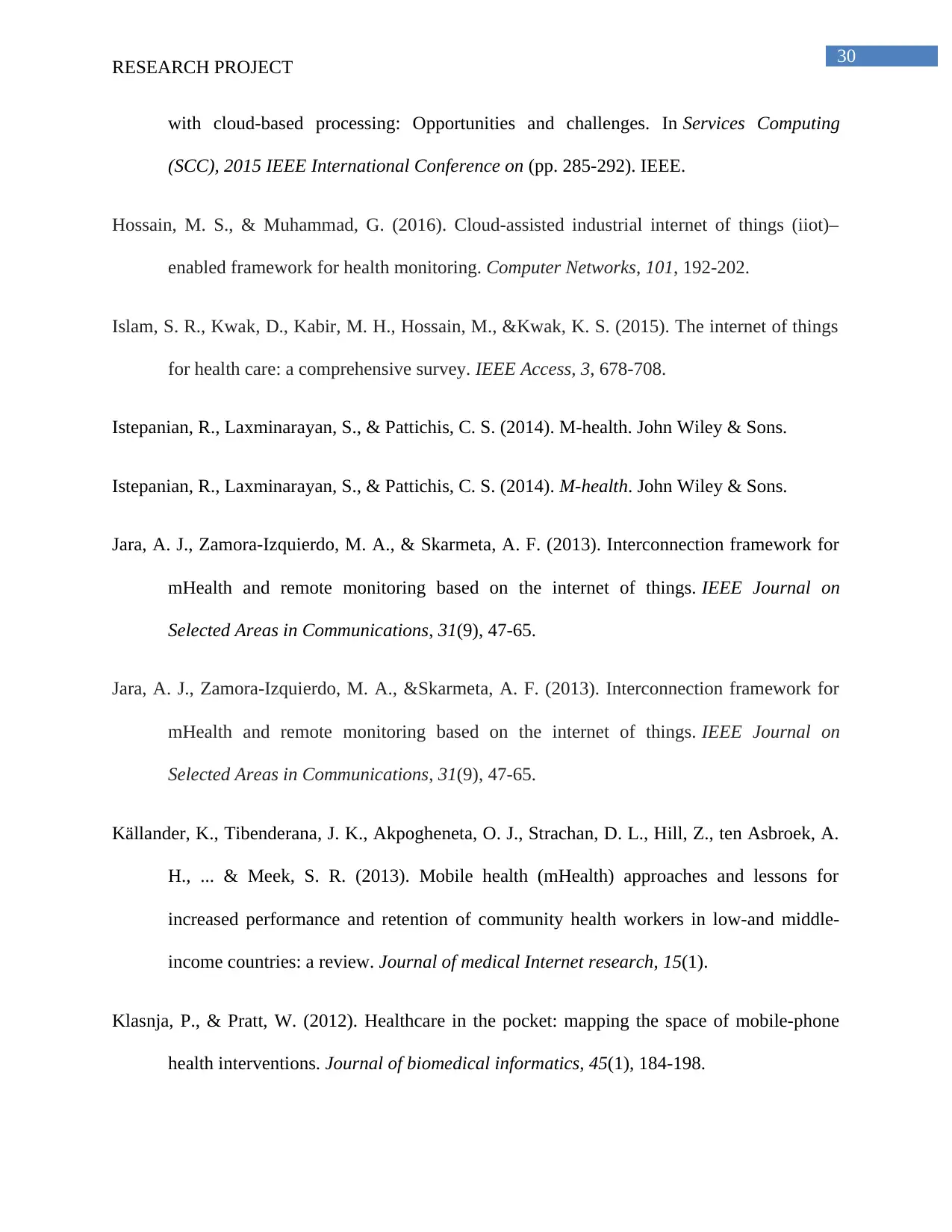
30
RESEARCH PROJECT
with cloud-based processing: Opportunities and challenges. In Services Computing
(SCC), 2015 IEEE International Conference on (pp. 285-292). IEEE.
Hossain, M. S., & Muhammad, G. (2016). Cloud-assisted industrial internet of things (iiot)–
enabled framework for health monitoring. Computer Networks, 101, 192-202.
Islam, S. R., Kwak, D., Kabir, M. H., Hossain, M., &Kwak, K. S. (2015). The internet of things
for health care: a comprehensive survey. IEEE Access, 3, 678-708.
Istepanian, R., Laxminarayan, S., & Pattichis, C. S. (2014). M-health. John Wiley & Sons.
Istepanian, R., Laxminarayan, S., & Pattichis, C. S. (2014). M-health. John Wiley & Sons.
Jara, A. J., Zamora-Izquierdo, M. A., & Skarmeta, A. F. (2013). Interconnection framework for
mHealth and remote monitoring based on the internet of things. IEEE Journal on
Selected Areas in Communications, 31(9), 47-65.
Jara, A. J., Zamora-Izquierdo, M. A., &Skarmeta, A. F. (2013). Interconnection framework for
mHealth and remote monitoring based on the internet of things. IEEE Journal on
Selected Areas in Communications, 31(9), 47-65.
Källander, K., Tibenderana, J. K., Akpogheneta, O. J., Strachan, D. L., Hill, Z., ten Asbroek, A.
H., ... & Meek, S. R. (2013). Mobile health (mHealth) approaches and lessons for
increased performance and retention of community health workers in low-and middle-
income countries: a review. Journal of medical Internet research, 15(1).
Klasnja, P., & Pratt, W. (2012). Healthcare in the pocket: mapping the space of mobile-phone
health interventions. Journal of biomedical informatics, 45(1), 184-198.
RESEARCH PROJECT
with cloud-based processing: Opportunities and challenges. In Services Computing
(SCC), 2015 IEEE International Conference on (pp. 285-292). IEEE.
Hossain, M. S., & Muhammad, G. (2016). Cloud-assisted industrial internet of things (iiot)–
enabled framework for health monitoring. Computer Networks, 101, 192-202.
Islam, S. R., Kwak, D., Kabir, M. H., Hossain, M., &Kwak, K. S. (2015). The internet of things
for health care: a comprehensive survey. IEEE Access, 3, 678-708.
Istepanian, R., Laxminarayan, S., & Pattichis, C. S. (2014). M-health. John Wiley & Sons.
Istepanian, R., Laxminarayan, S., & Pattichis, C. S. (2014). M-health. John Wiley & Sons.
Jara, A. J., Zamora-Izquierdo, M. A., & Skarmeta, A. F. (2013). Interconnection framework for
mHealth and remote monitoring based on the internet of things. IEEE Journal on
Selected Areas in Communications, 31(9), 47-65.
Jara, A. J., Zamora-Izquierdo, M. A., &Skarmeta, A. F. (2013). Interconnection framework for
mHealth and remote monitoring based on the internet of things. IEEE Journal on
Selected Areas in Communications, 31(9), 47-65.
Källander, K., Tibenderana, J. K., Akpogheneta, O. J., Strachan, D. L., Hill, Z., ten Asbroek, A.
H., ... & Meek, S. R. (2013). Mobile health (mHealth) approaches and lessons for
increased performance and retention of community health workers in low-and middle-
income countries: a review. Journal of medical Internet research, 15(1).
Klasnja, P., & Pratt, W. (2012). Healthcare in the pocket: mapping the space of mobile-phone
health interventions. Journal of biomedical informatics, 45(1), 184-198.
Paraphrase This Document
Need a fresh take? Get an instant paraphrase of this document with our AI Paraphraser
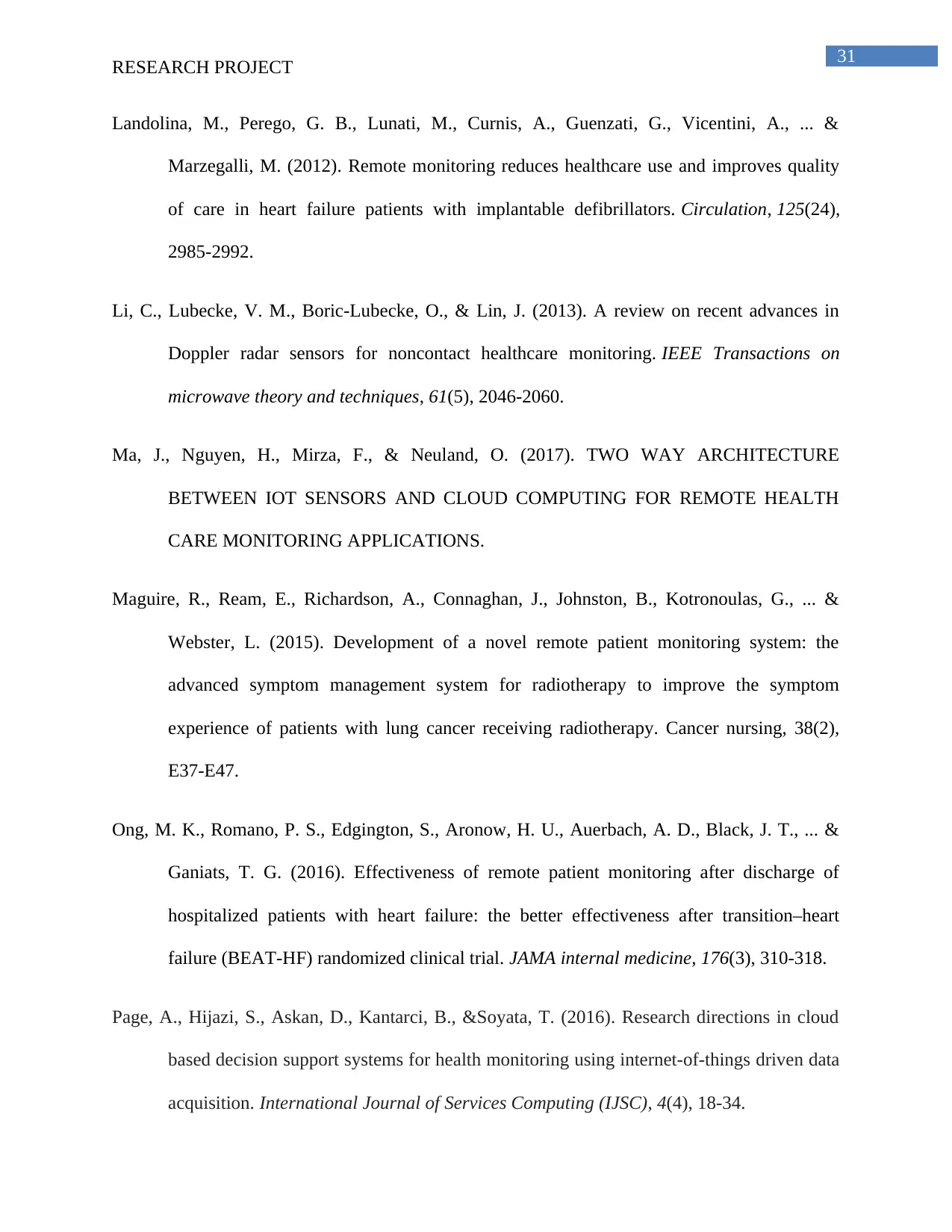
31
RESEARCH PROJECT
Landolina, M., Perego, G. B., Lunati, M., Curnis, A., Guenzati, G., Vicentini, A., ... &
Marzegalli, M. (2012). Remote monitoring reduces healthcare use and improves quality
of care in heart failure patients with implantable defibrillators. Circulation, 125(24),
2985-2992.
Li, C., Lubecke, V. M., Boric-Lubecke, O., & Lin, J. (2013). A review on recent advances in
Doppler radar sensors for noncontact healthcare monitoring. IEEE Transactions on
microwave theory and techniques, 61(5), 2046-2060.
Ma, J., Nguyen, H., Mirza, F., & Neuland, O. (2017). TWO WAY ARCHITECTURE
BETWEEN IOT SENSORS AND CLOUD COMPUTING FOR REMOTE HEALTH
CARE MONITORING APPLICATIONS.
Maguire, R., Ream, E., Richardson, A., Connaghan, J., Johnston, B., Kotronoulas, G., ... &
Webster, L. (2015). Development of a novel remote patient monitoring system: the
advanced symptom management system for radiotherapy to improve the symptom
experience of patients with lung cancer receiving radiotherapy. Cancer nursing, 38(2),
E37-E47.
Ong, M. K., Romano, P. S., Edgington, S., Aronow, H. U., Auerbach, A. D., Black, J. T., ... &
Ganiats, T. G. (2016). Effectiveness of remote patient monitoring after discharge of
hospitalized patients with heart failure: the better effectiveness after transition–heart
failure (BEAT-HF) randomized clinical trial. JAMA internal medicine, 176(3), 310-318.
Page, A., Hijazi, S., Askan, D., Kantarci, B., &Soyata, T. (2016). Research directions in cloud
based decision support systems for health monitoring using internet-of-things driven data
acquisition. International Journal of Services Computing (IJSC), 4(4), 18-34.
RESEARCH PROJECT
Landolina, M., Perego, G. B., Lunati, M., Curnis, A., Guenzati, G., Vicentini, A., ... &
Marzegalli, M. (2012). Remote monitoring reduces healthcare use and improves quality
of care in heart failure patients with implantable defibrillators. Circulation, 125(24),
2985-2992.
Li, C., Lubecke, V. M., Boric-Lubecke, O., & Lin, J. (2013). A review on recent advances in
Doppler radar sensors for noncontact healthcare monitoring. IEEE Transactions on
microwave theory and techniques, 61(5), 2046-2060.
Ma, J., Nguyen, H., Mirza, F., & Neuland, O. (2017). TWO WAY ARCHITECTURE
BETWEEN IOT SENSORS AND CLOUD COMPUTING FOR REMOTE HEALTH
CARE MONITORING APPLICATIONS.
Maguire, R., Ream, E., Richardson, A., Connaghan, J., Johnston, B., Kotronoulas, G., ... &
Webster, L. (2015). Development of a novel remote patient monitoring system: the
advanced symptom management system for radiotherapy to improve the symptom
experience of patients with lung cancer receiving radiotherapy. Cancer nursing, 38(2),
E37-E47.
Ong, M. K., Romano, P. S., Edgington, S., Aronow, H. U., Auerbach, A. D., Black, J. T., ... &
Ganiats, T. G. (2016). Effectiveness of remote patient monitoring after discharge of
hospitalized patients with heart failure: the better effectiveness after transition–heart
failure (BEAT-HF) randomized clinical trial. JAMA internal medicine, 176(3), 310-318.
Page, A., Hijazi, S., Askan, D., Kantarci, B., &Soyata, T. (2016). Research directions in cloud
based decision support systems for health monitoring using internet-of-things driven data
acquisition. International Journal of Services Computing (IJSC), 4(4), 18-34.
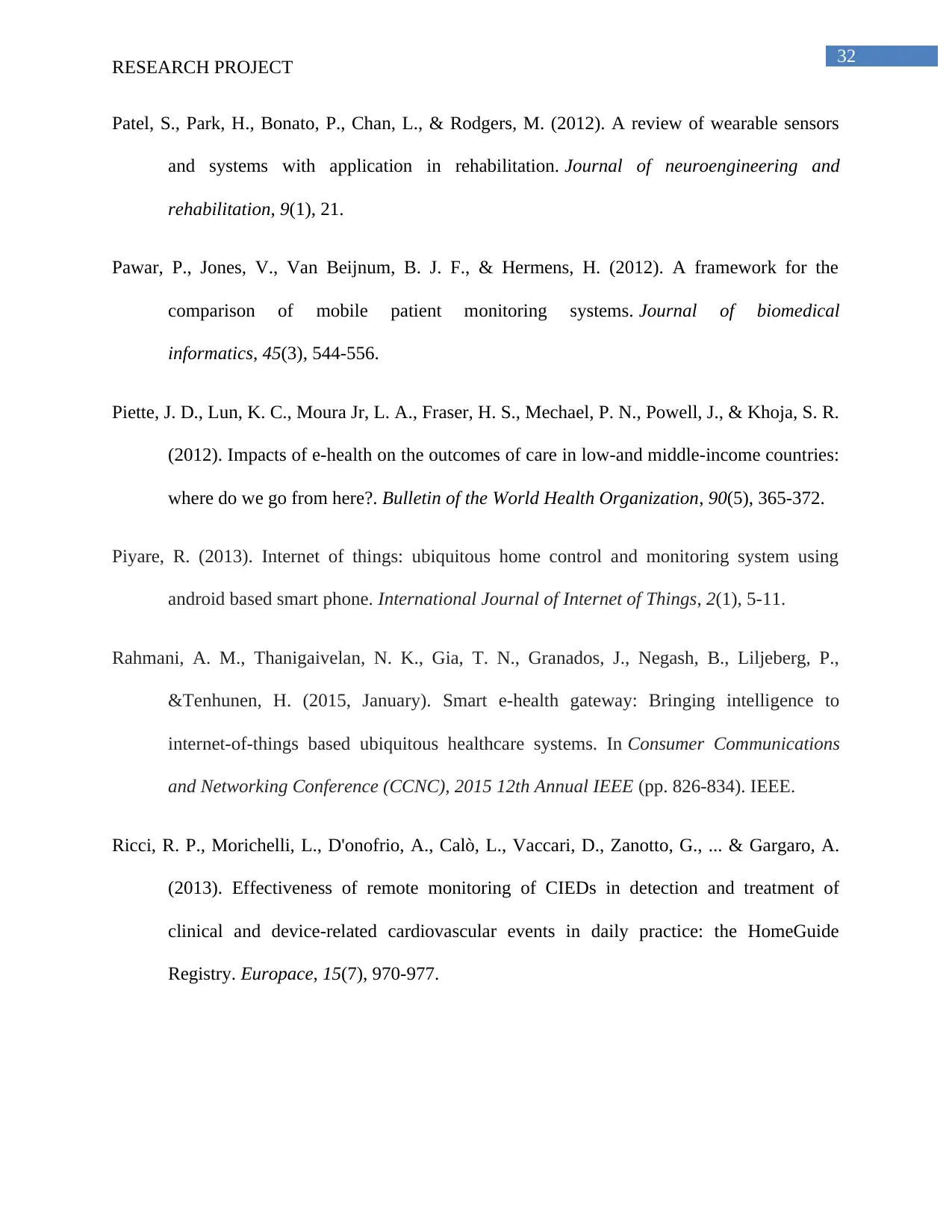
32
RESEARCH PROJECT
Patel, S., Park, H., Bonato, P., Chan, L., & Rodgers, M. (2012). A review of wearable sensors
and systems with application in rehabilitation. Journal of neuroengineering and
rehabilitation, 9(1), 21.
Pawar, P., Jones, V., Van Beijnum, B. J. F., & Hermens, H. (2012). A framework for the
comparison of mobile patient monitoring systems. Journal of biomedical
informatics, 45(3), 544-556.
Piette, J. D., Lun, K. C., Moura Jr, L. A., Fraser, H. S., Mechael, P. N., Powell, J., & Khoja, S. R.
(2012). Impacts of e-health on the outcomes of care in low-and middle-income countries:
where do we go from here?. Bulletin of the World Health Organization, 90(5), 365-372.
Piyare, R. (2013). Internet of things: ubiquitous home control and monitoring system using
android based smart phone. International Journal of Internet of Things, 2(1), 5-11.
Rahmani, A. M., Thanigaivelan, N. K., Gia, T. N., Granados, J., Negash, B., Liljeberg, P.,
&Tenhunen, H. (2015, January). Smart e-health gateway: Bringing intelligence to
internet-of-things based ubiquitous healthcare systems. In Consumer Communications
and Networking Conference (CCNC), 2015 12th Annual IEEE (pp. 826-834). IEEE.
Ricci, R. P., Morichelli, L., D'onofrio, A., Calò, L., Vaccari, D., Zanotto, G., ... & Gargaro, A.
(2013). Effectiveness of remote monitoring of CIEDs in detection and treatment of
clinical and device-related cardiovascular events in daily practice: the HomeGuide
Registry. Europace, 15(7), 970-977.
RESEARCH PROJECT
Patel, S., Park, H., Bonato, P., Chan, L., & Rodgers, M. (2012). A review of wearable sensors
and systems with application in rehabilitation. Journal of neuroengineering and
rehabilitation, 9(1), 21.
Pawar, P., Jones, V., Van Beijnum, B. J. F., & Hermens, H. (2012). A framework for the
comparison of mobile patient monitoring systems. Journal of biomedical
informatics, 45(3), 544-556.
Piette, J. D., Lun, K. C., Moura Jr, L. A., Fraser, H. S., Mechael, P. N., Powell, J., & Khoja, S. R.
(2012). Impacts of e-health on the outcomes of care in low-and middle-income countries:
where do we go from here?. Bulletin of the World Health Organization, 90(5), 365-372.
Piyare, R. (2013). Internet of things: ubiquitous home control and monitoring system using
android based smart phone. International Journal of Internet of Things, 2(1), 5-11.
Rahmani, A. M., Thanigaivelan, N. K., Gia, T. N., Granados, J., Negash, B., Liljeberg, P.,
&Tenhunen, H. (2015, January). Smart e-health gateway: Bringing intelligence to
internet-of-things based ubiquitous healthcare systems. In Consumer Communications
and Networking Conference (CCNC), 2015 12th Annual IEEE (pp. 826-834). IEEE.
Ricci, R. P., Morichelli, L., D'onofrio, A., Calò, L., Vaccari, D., Zanotto, G., ... & Gargaro, A.
(2013). Effectiveness of remote monitoring of CIEDs in detection and treatment of
clinical and device-related cardiovascular events in daily practice: the HomeGuide
Registry. Europace, 15(7), 970-977.
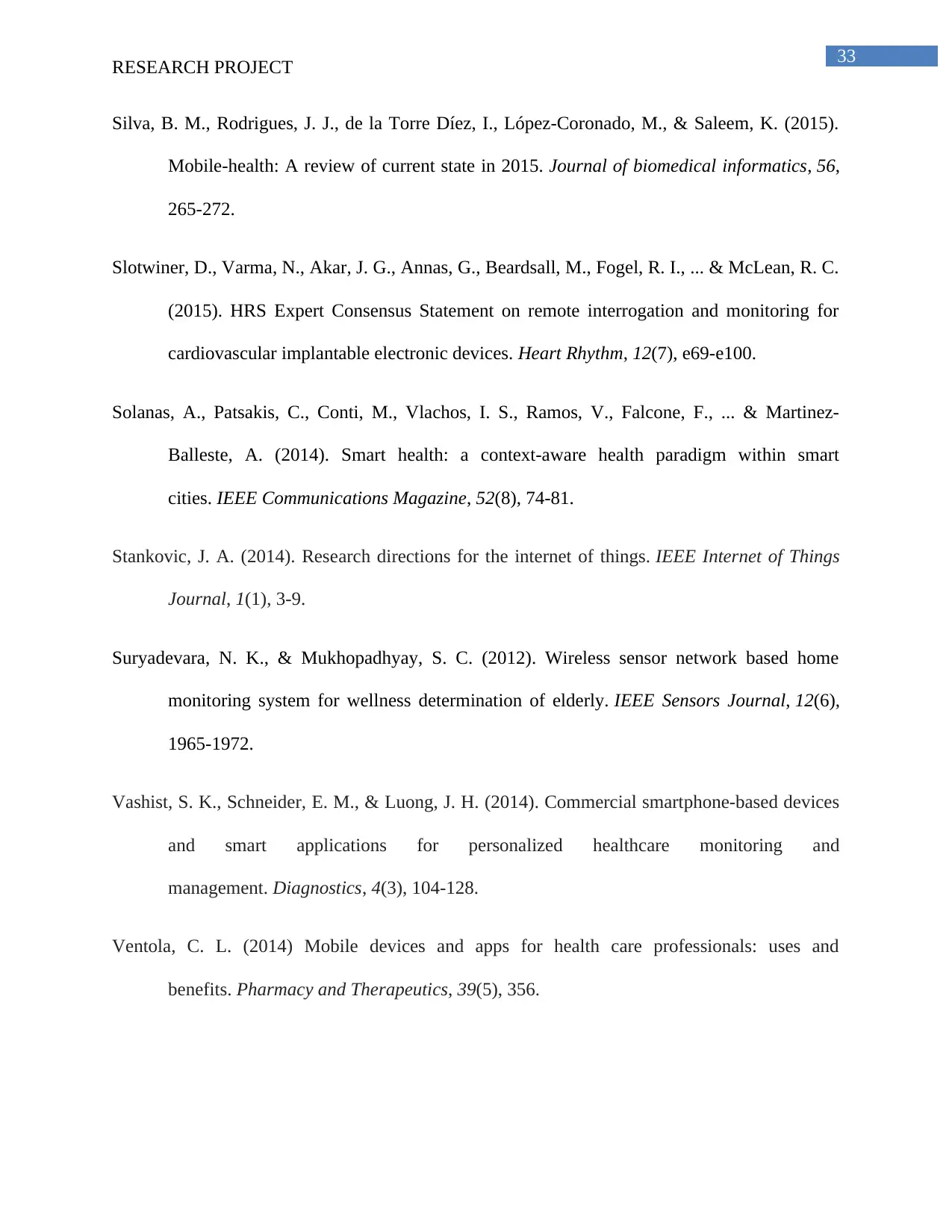
33
RESEARCH PROJECT
Silva, B. M., Rodrigues, J. J., de la Torre Díez, I., López-Coronado, M., & Saleem, K. (2015).
Mobile-health: A review of current state in 2015. Journal of biomedical informatics, 56,
265-272.
Slotwiner, D., Varma, N., Akar, J. G., Annas, G., Beardsall, M., Fogel, R. I., ... & McLean, R. C.
(2015). HRS Expert Consensus Statement on remote interrogation and monitoring for
cardiovascular implantable electronic devices. Heart Rhythm, 12(7), e69-e100.
Solanas, A., Patsakis, C., Conti, M., Vlachos, I. S., Ramos, V., Falcone, F., ... & Martinez-
Balleste, A. (2014). Smart health: a context-aware health paradigm within smart
cities. IEEE Communications Magazine, 52(8), 74-81.
Stankovic, J. A. (2014). Research directions for the internet of things. IEEE Internet of Things
Journal, 1(1), 3-9.
Suryadevara, N. K., & Mukhopadhyay, S. C. (2012). Wireless sensor network based home
monitoring system for wellness determination of elderly. IEEE Sensors Journal, 12(6),
1965-1972.
Vashist, S. K., Schneider, E. M., & Luong, J. H. (2014). Commercial smartphone-based devices
and smart applications for personalized healthcare monitoring and
management. Diagnostics, 4(3), 104-128.
Ventola, C. L. (2014) Mobile devices and apps for health care professionals: uses and
benefits. Pharmacy and Therapeutics, 39(5), 356.
RESEARCH PROJECT
Silva, B. M., Rodrigues, J. J., de la Torre Díez, I., López-Coronado, M., & Saleem, K. (2015).
Mobile-health: A review of current state in 2015. Journal of biomedical informatics, 56,
265-272.
Slotwiner, D., Varma, N., Akar, J. G., Annas, G., Beardsall, M., Fogel, R. I., ... & McLean, R. C.
(2015). HRS Expert Consensus Statement on remote interrogation and monitoring for
cardiovascular implantable electronic devices. Heart Rhythm, 12(7), e69-e100.
Solanas, A., Patsakis, C., Conti, M., Vlachos, I. S., Ramos, V., Falcone, F., ... & Martinez-
Balleste, A. (2014). Smart health: a context-aware health paradigm within smart
cities. IEEE Communications Magazine, 52(8), 74-81.
Stankovic, J. A. (2014). Research directions for the internet of things. IEEE Internet of Things
Journal, 1(1), 3-9.
Suryadevara, N. K., & Mukhopadhyay, S. C. (2012). Wireless sensor network based home
monitoring system for wellness determination of elderly. IEEE Sensors Journal, 12(6),
1965-1972.
Vashist, S. K., Schneider, E. M., & Luong, J. H. (2014). Commercial smartphone-based devices
and smart applications for personalized healthcare monitoring and
management. Diagnostics, 4(3), 104-128.
Ventola, C. L. (2014) Mobile devices and apps for health care professionals: uses and
benefits. Pharmacy and Therapeutics, 39(5), 356.
Secure Best Marks with AI Grader
Need help grading? Try our AI Grader for instant feedback on your assignments.
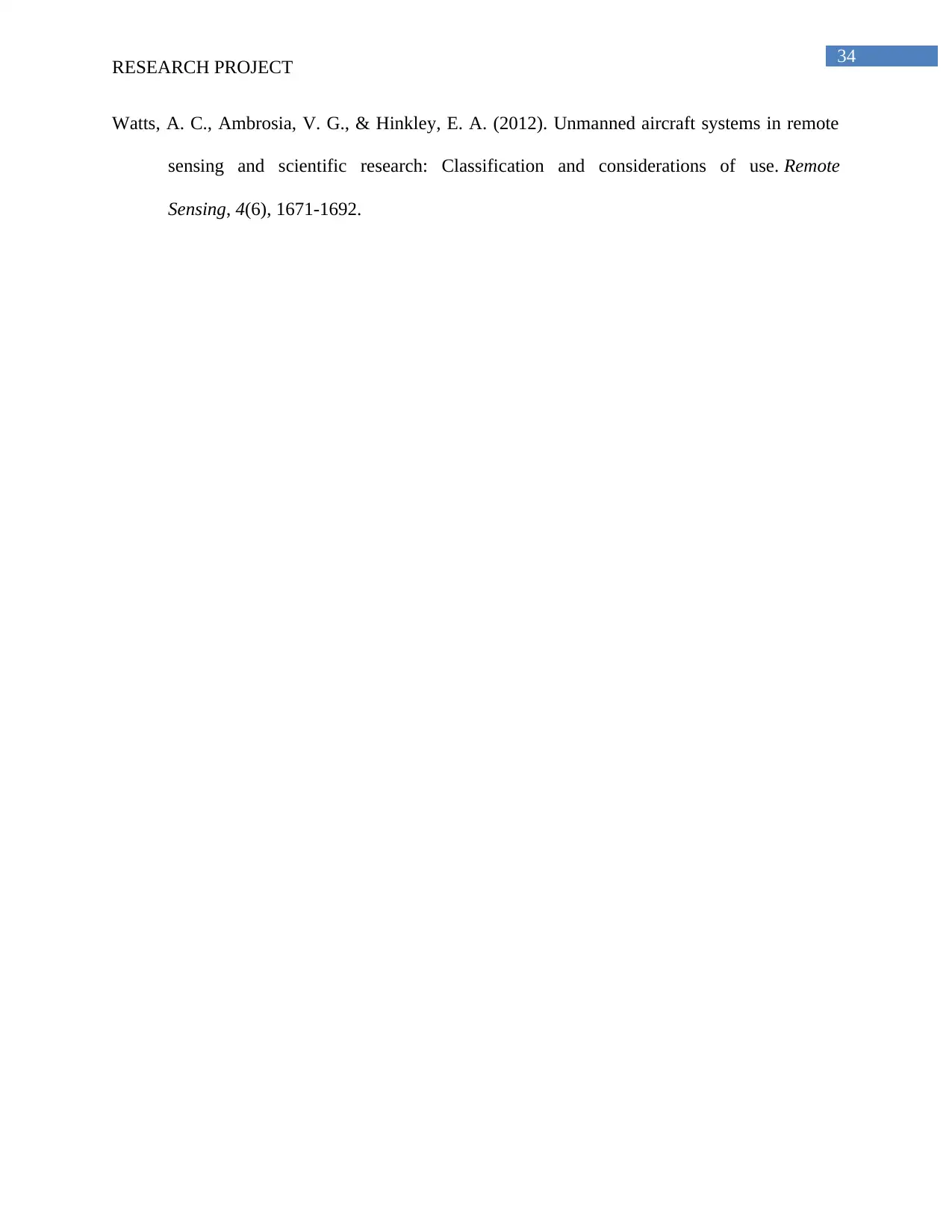
34
RESEARCH PROJECT
Watts, A. C., Ambrosia, V. G., & Hinkley, E. A. (2012). Unmanned aircraft systems in remote
sensing and scientific research: Classification and considerations of use. Remote
Sensing, 4(6), 1671-1692.
RESEARCH PROJECT
Watts, A. C., Ambrosia, V. G., & Hinkley, E. A. (2012). Unmanned aircraft systems in remote
sensing and scientific research: Classification and considerations of use. Remote
Sensing, 4(6), 1671-1692.
1 out of 35
Related Documents
Your All-in-One AI-Powered Toolkit for Academic Success.
+13062052269
info@desklib.com
Available 24*7 on WhatsApp / Email
![[object Object]](/_next/static/media/star-bottom.7253800d.svg)
Unlock your academic potential
© 2024 | Zucol Services PVT LTD | All rights reserved.





